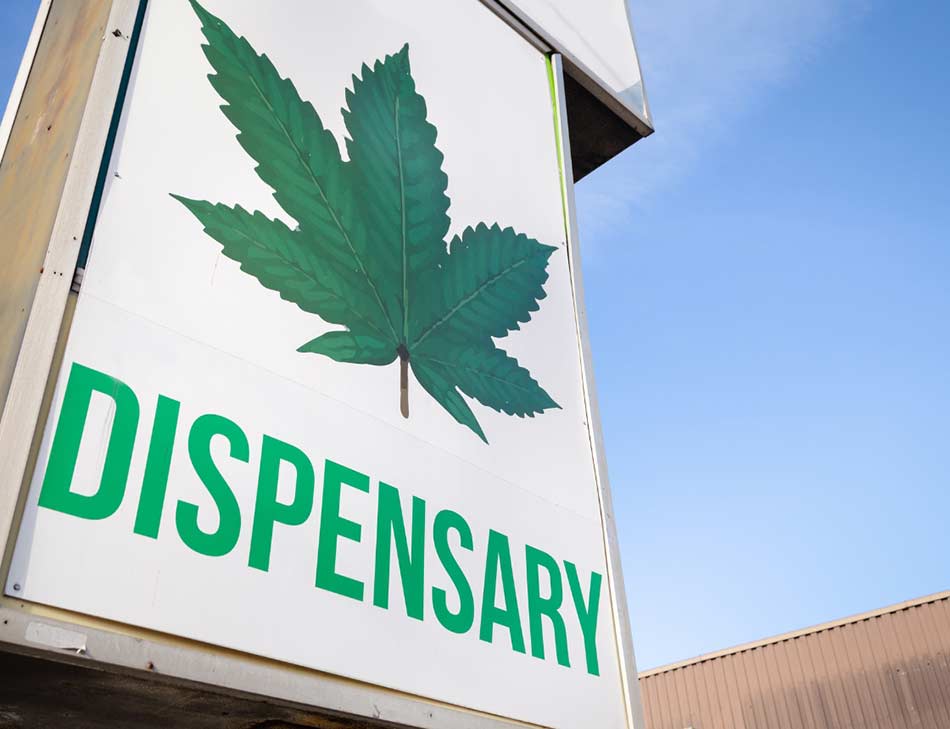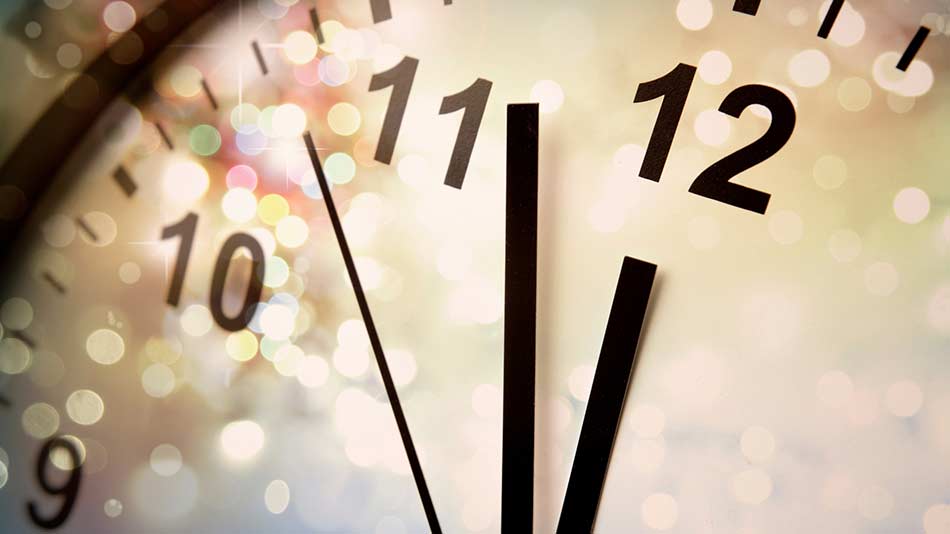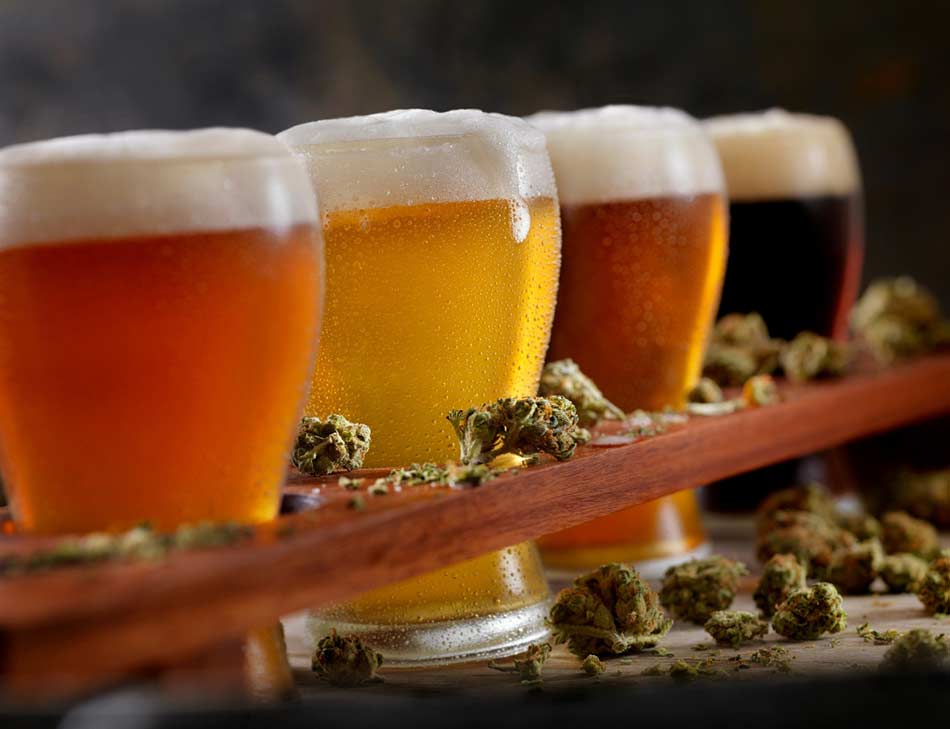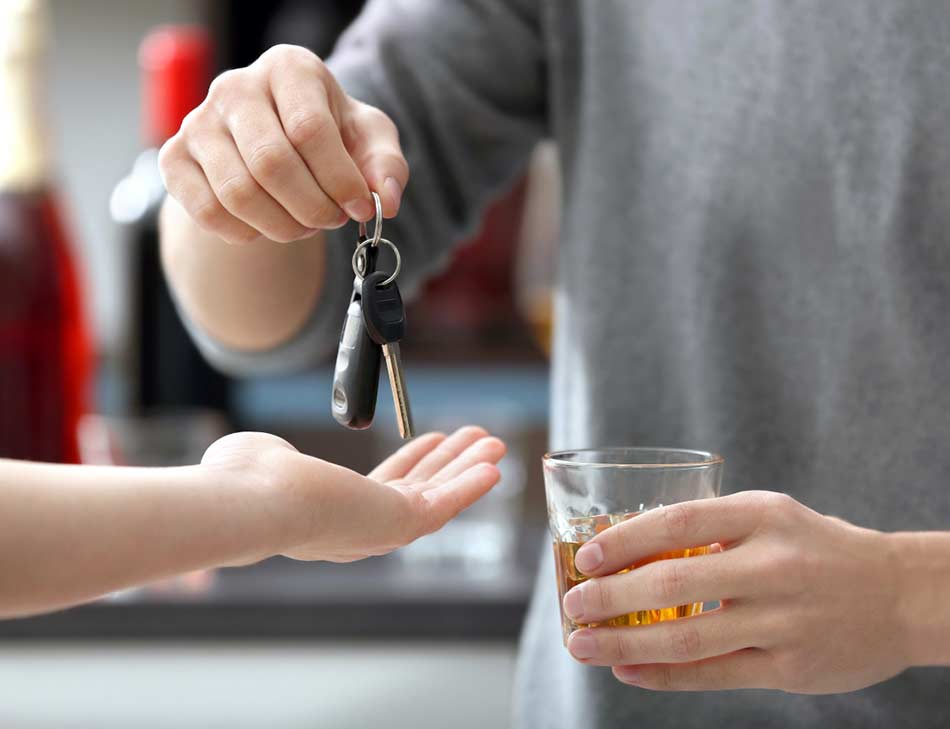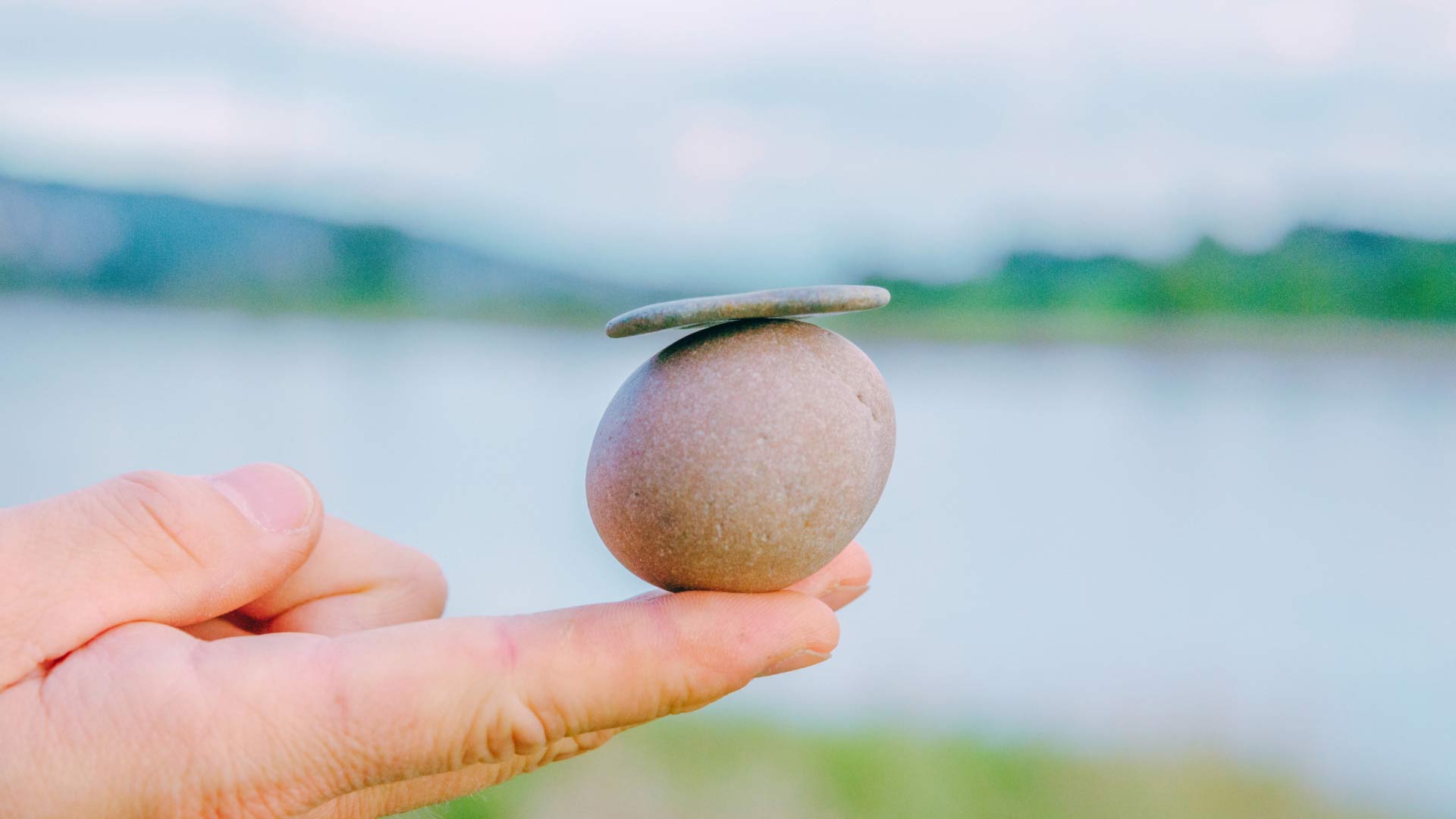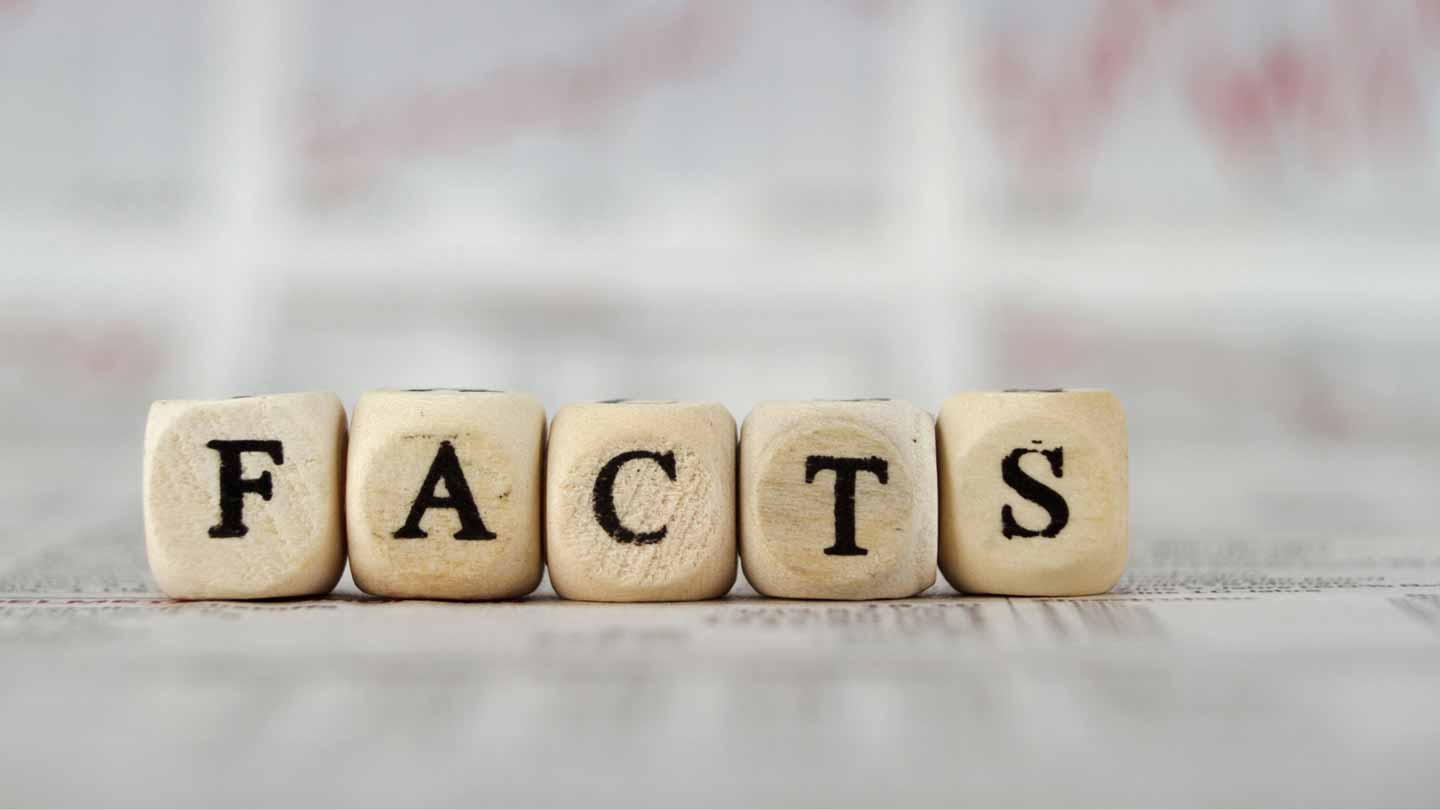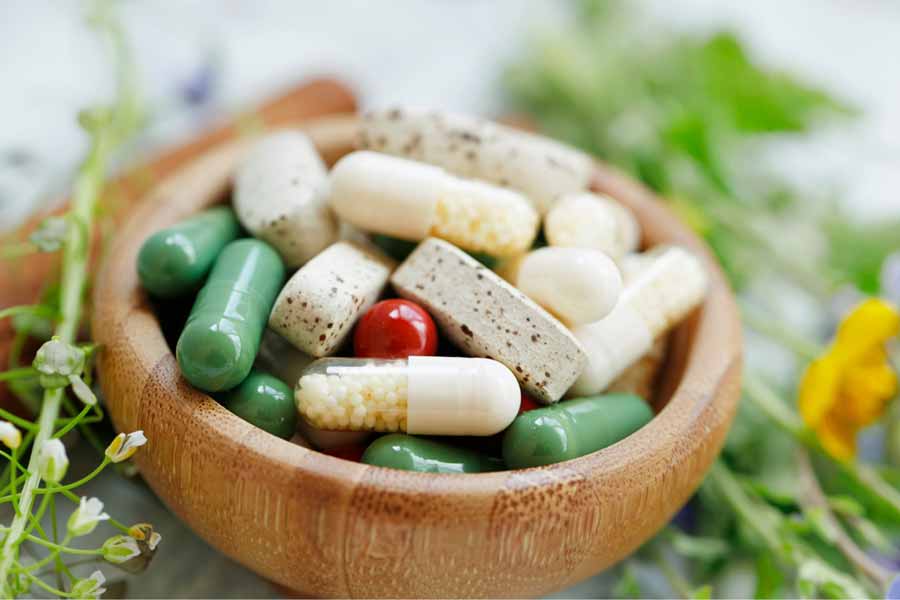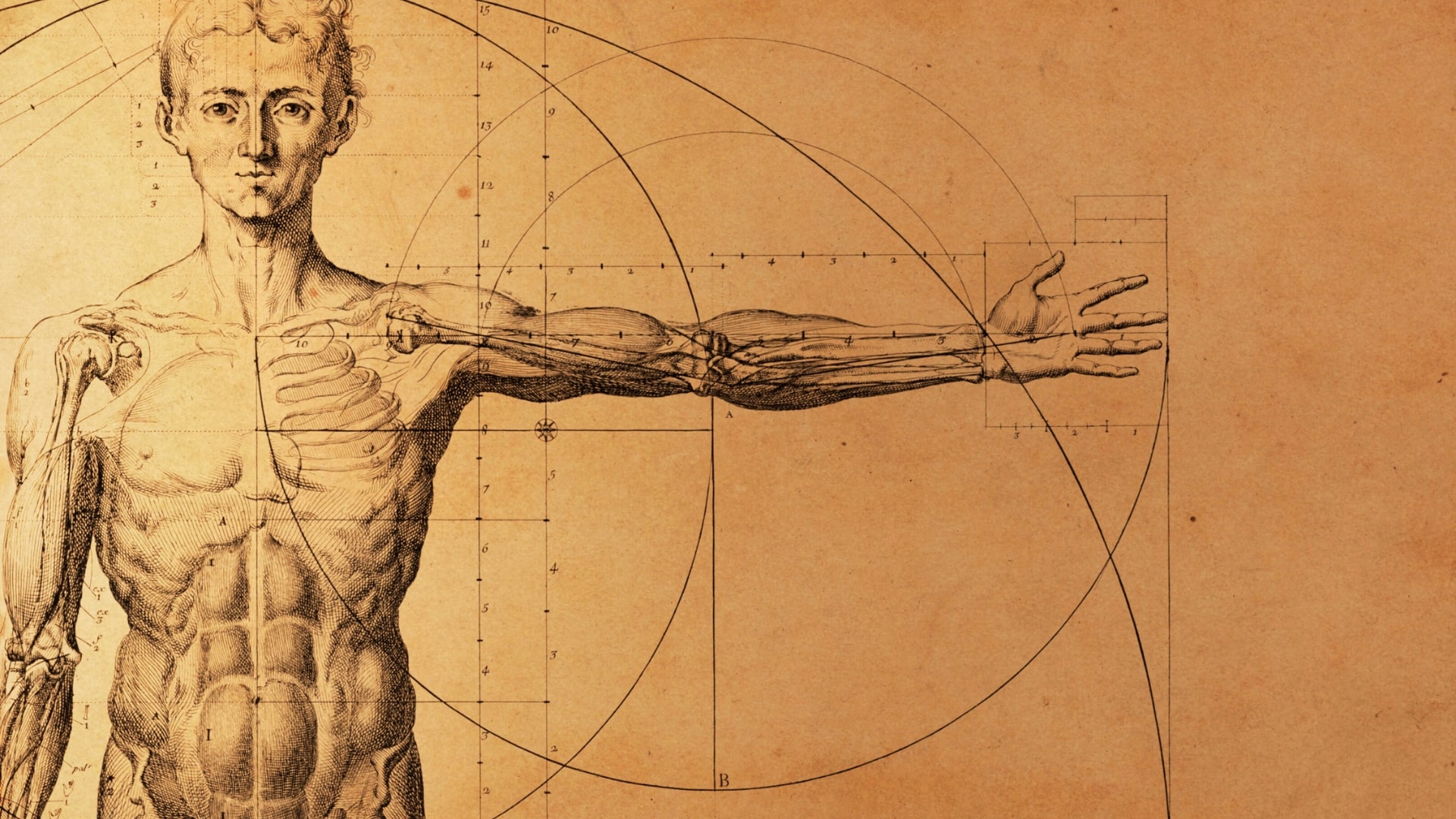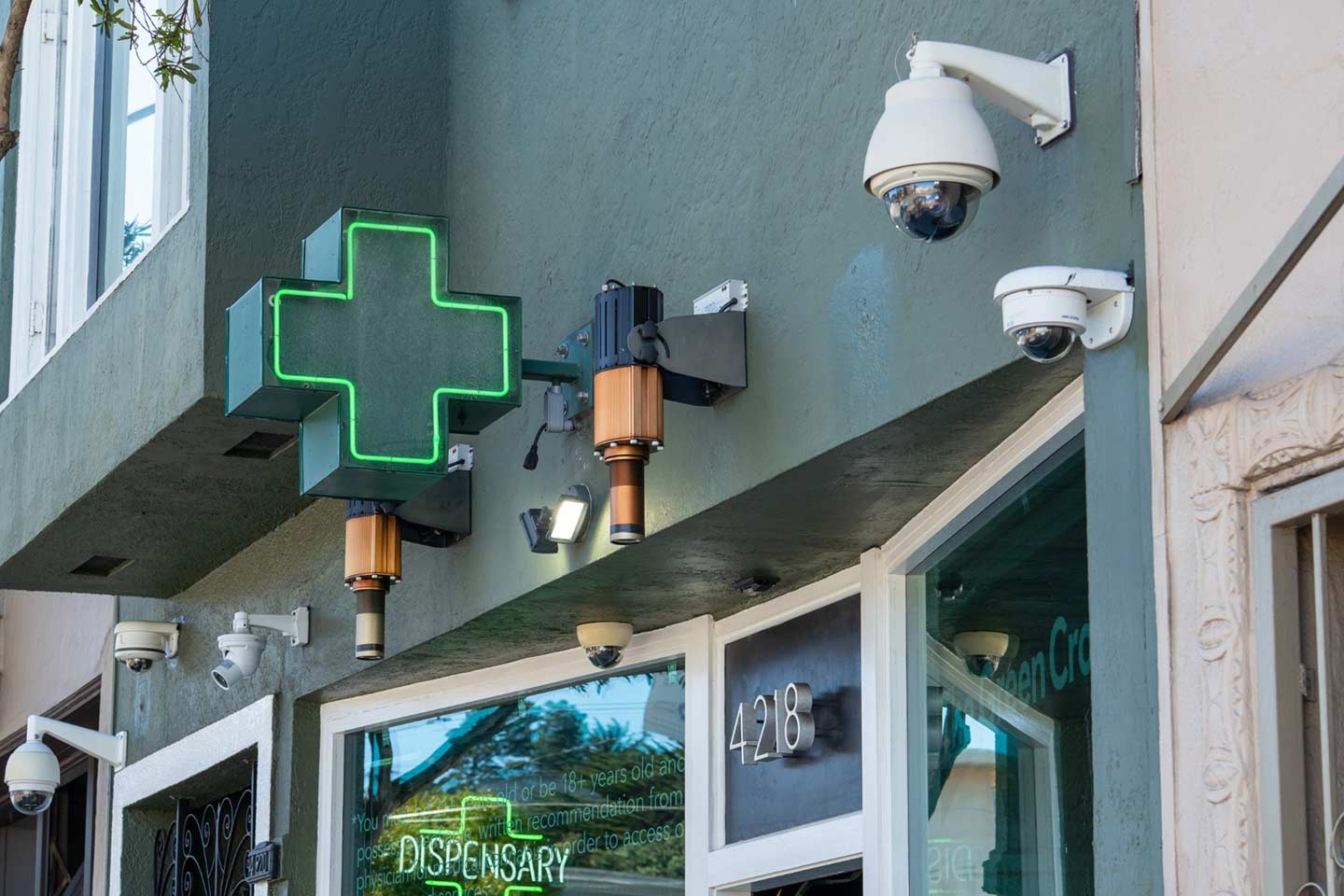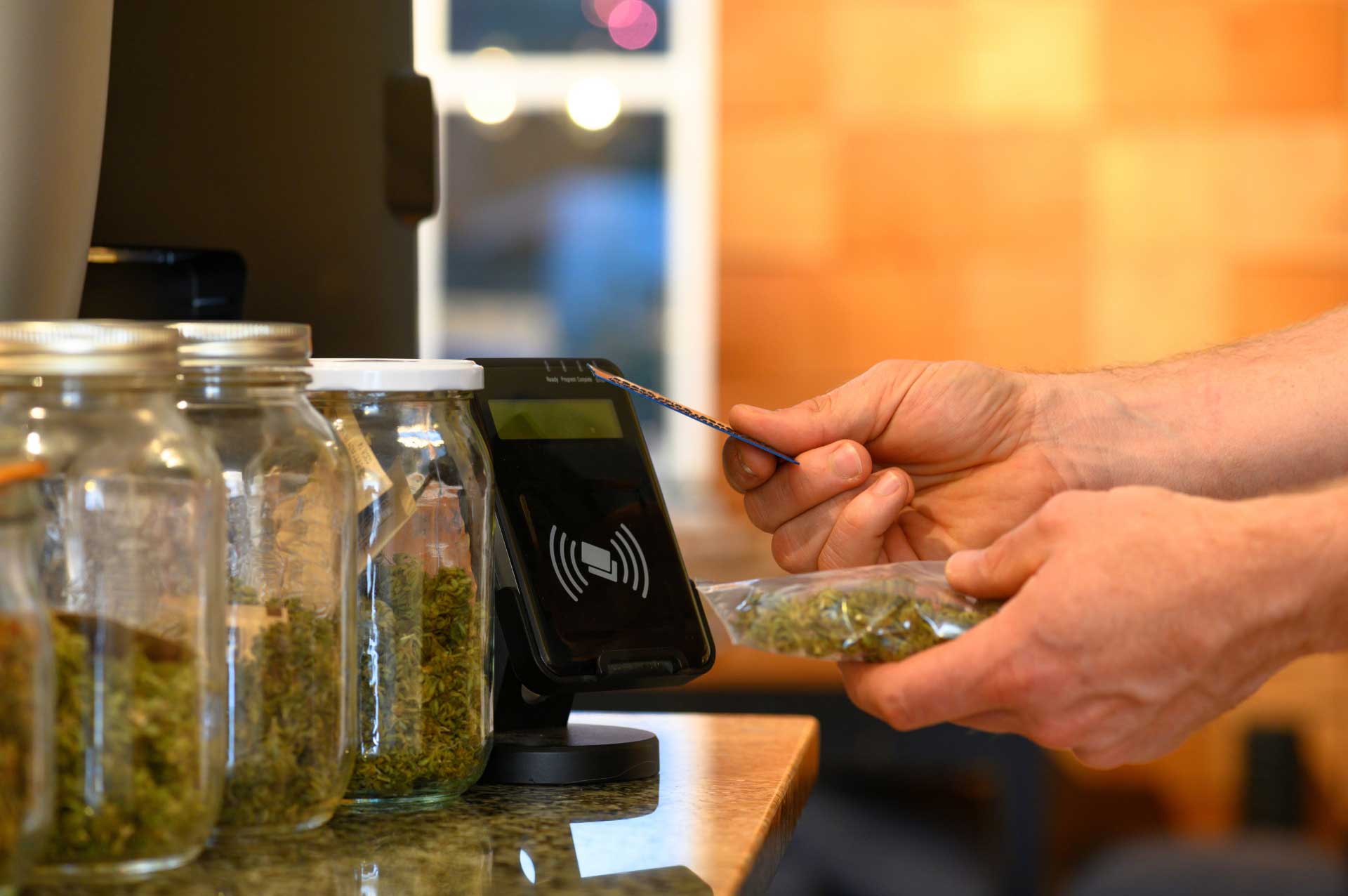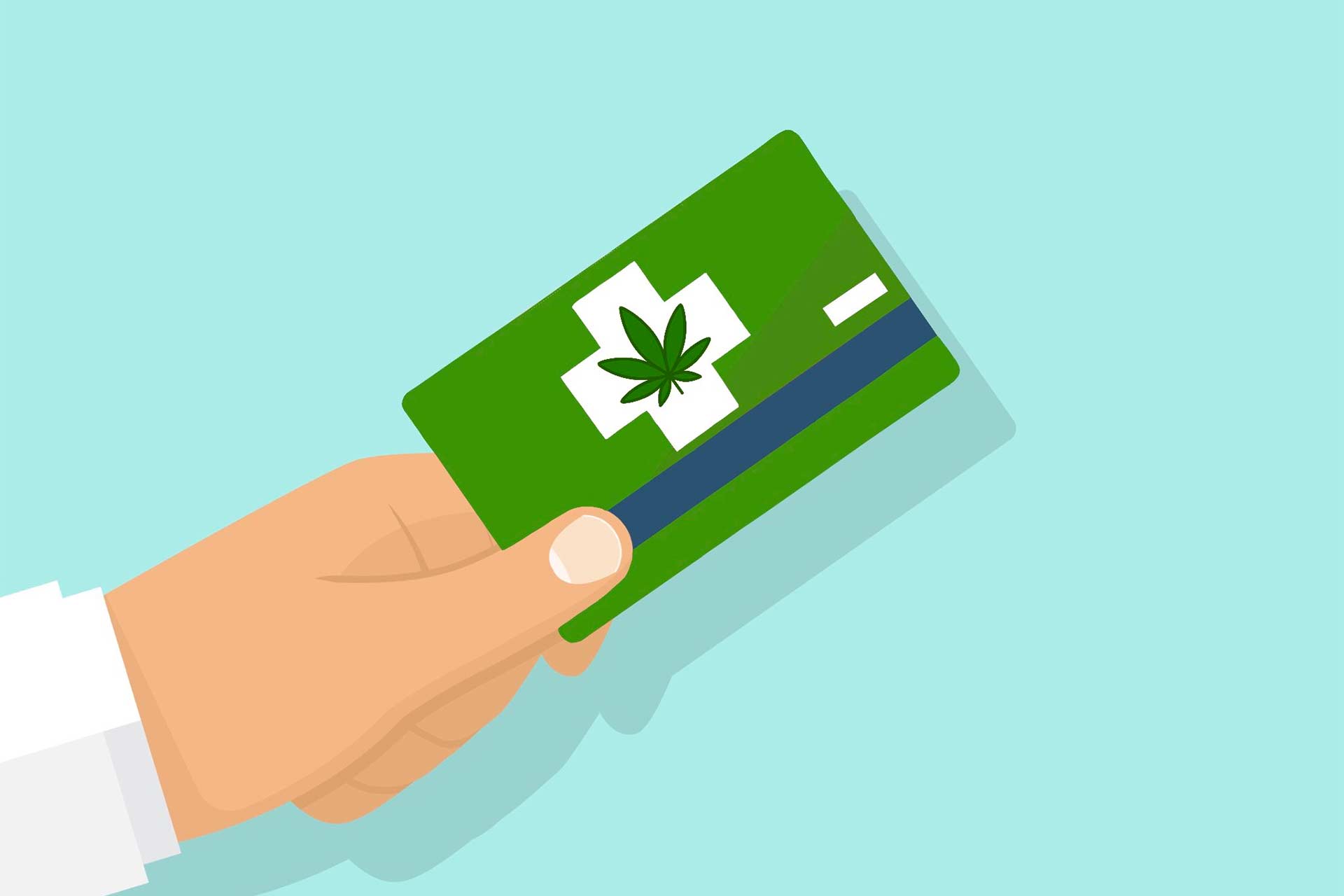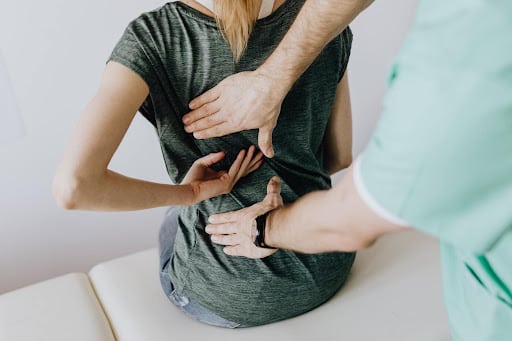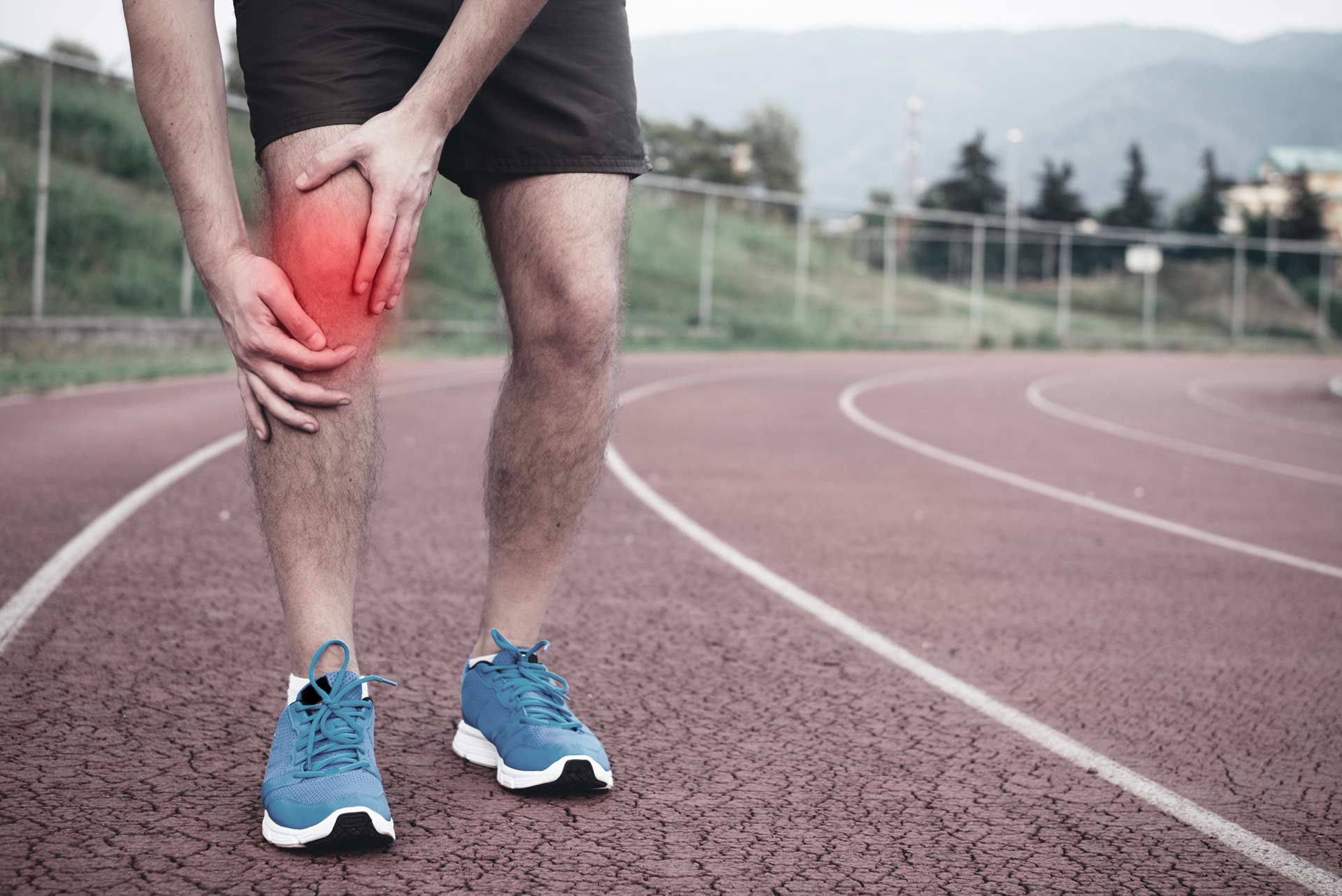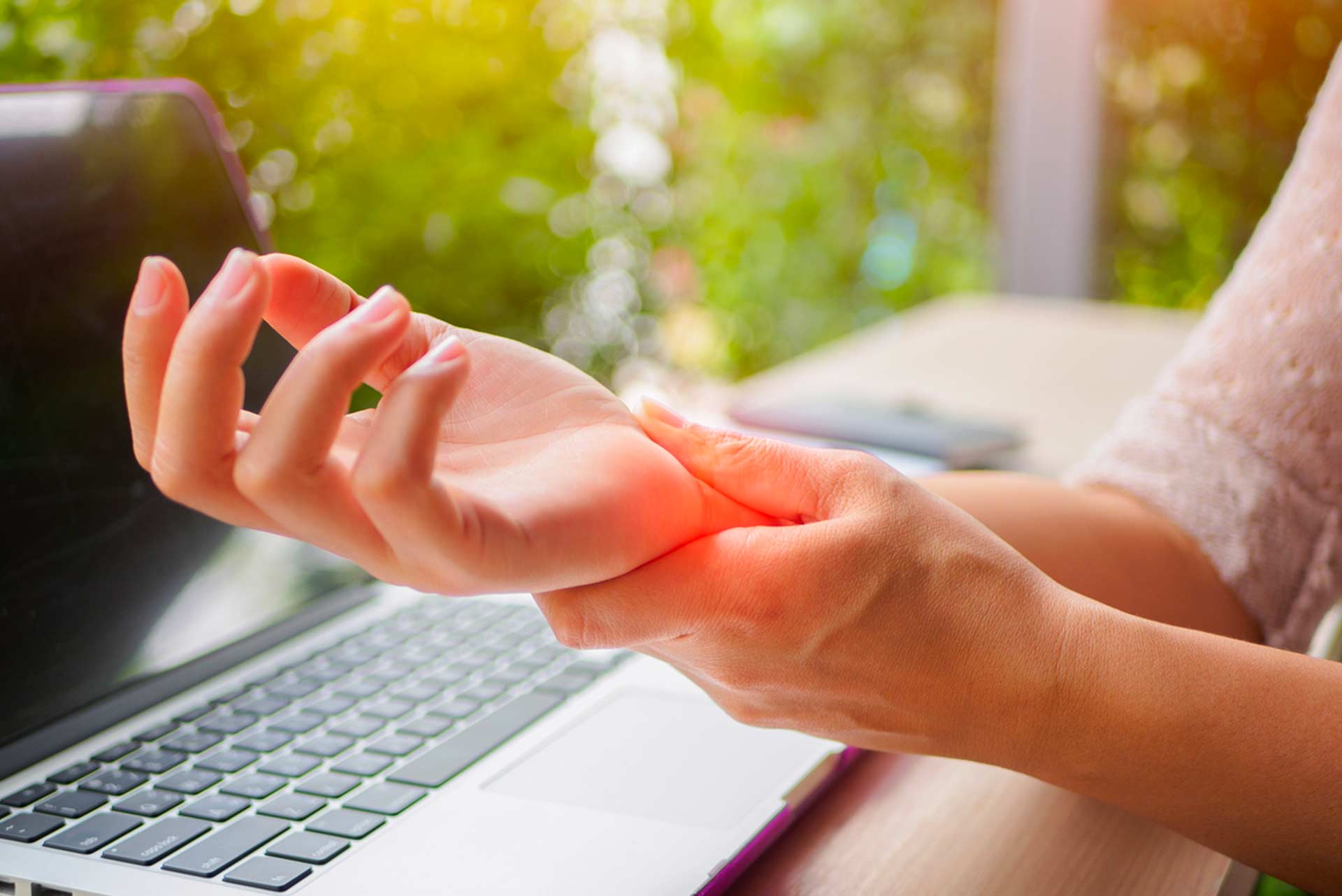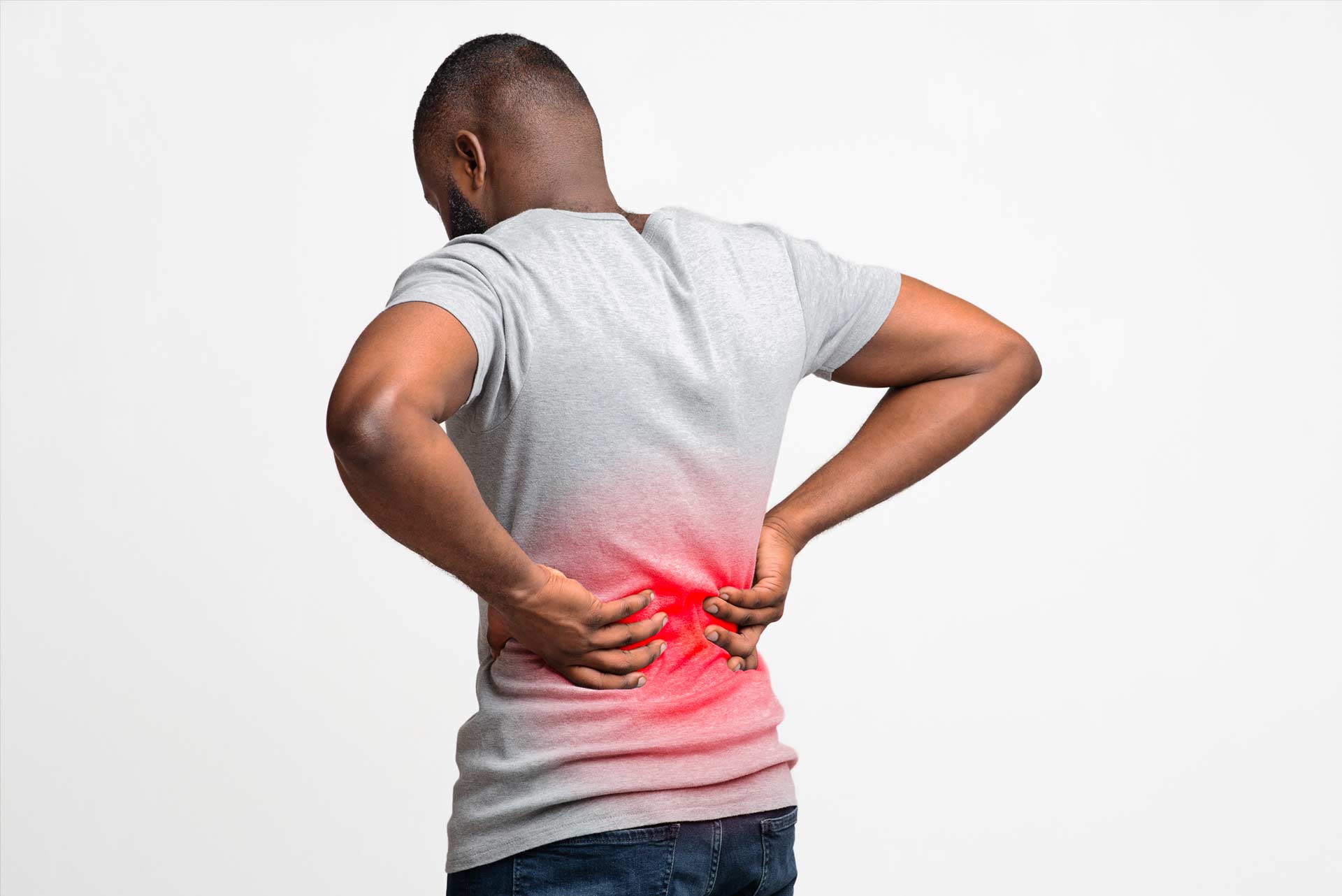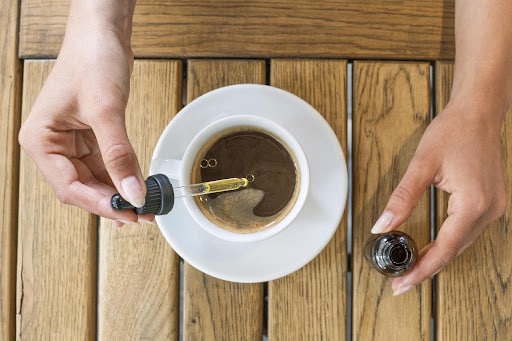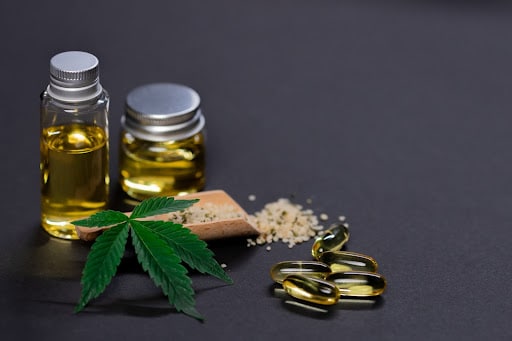A Beginner’s Guide to Cannabis-Infused Beverages for Celebrations
Photo: Canva / Denys Gromov
Exploring THC-infused seltzers, sodas, and cocktails for social gatherings
Medically reviewed by Katherine Golden, RN
Whether you’re toasting a new year – new you, cheering for your favorite Super Bowl team, or kicking back with friends at a Memorial Day cookout, the odds are greater than ever that cannabis-infused seltzers, sodas, or cocktails might be part of your plan. While THC-infused beverages are modeled after more familiar alcoholic drinks like beer and hard spirits, their effects can be very different than an alcoholic buzz, especially for people who are new to cannabis as well as for casual cannabis users.
Key differences between alcoholic drinks and THC-infused drinks:
- Psychoactive Effects: THC-infused drinks offer a unique psychoactive experience that’s distinct from an alcohol buzz.
- Social Effects: Cannabis-infused beverages can bring about a different social dynamic compared to alcoholic drinks.
- Onset and Duration: The effects of THC-infused beverages may differ significantly in terms of onset time and duration compared to the effects of alcoholic drinks.
- After-effects: THC-infused beverages offer relaxation and euphoria and in most cases, without the risk of a hangover the next day.
More people are turning to cannabis beverages as a fun no-hangover alternative for celebrations, but is this product the best fit for you? We take a look at the state of THC beverages, including how much to drink and expected effects, so that you can go into your celebrations confident you’re making the best decisions around consumption.
What are THC-infused beverages?
Cannabis-infused beverages contain a unique blend of cannabinoids that deliver a distinctive experience. THC-infused beers, seltzers, and pre-made cocktails offer a novel way to embrace cannabis in social settings, especially in indoor spaces where smoking and vaping may be frowned upon or prohibited. You can also find THC beverage powders and drops that can easily be added to non-alcoholic seltzer, water or juice to craft your own unique mixed drink.
Most cannabis beverages sold today use nanoemulsion technology that allows the THC to be more rapidly absorbed by the body, leading to faster effects that are more in line with smoking cannabis. Your own body’s endocannabinoid system also affects how quickly you’ll feel effects, as well as other factors like whether you’ve recently eaten.
Are THC-infused beverages legal in my area?
Cannabis laws vary from state to state, but if medical cannabis or adult-use recreational cannabis is legal in your state, then THC-infused beverages will likely be available as an option in legal dispensaries.
State laws will also likely limit how much THC you can buy per day. This makes cannabis beverages different from alcohol that can be bought in bulk before a party. Keep the daily cannabis buying limits in mind if you’re planning to share sparkling cannabis beverages with legal-aged friends at a social gathering.
Also, keep in mind that state laws limit where you can consume THC products including cannabis-infused beverages. While a can of THC-infused seltzer may look just like a can of hard seltzer that contains alcohol, the laws are very different on public consumption of these two products.

How strong are cannabis beverages?
The answer to this question is tricky. Cannabis beverage potencies are regulated at the state level. This means that depending on where you live, cannabis beverages may be limited to 5 mg THC or 10 mg of THC per serving or per can.
However, some states have much higher limits. For example, California allows the sale of adult-use cannabis beverages containing 100 mg THC per container, while Oklahoma’s medical cannabis laws allow for much more potent drinks that may contain 1000 mg THC per container.
Of course even if you live in a state that allows high-potency cannabis beverages, it’s likely that lower-potency options will be available for sale.
Your best bet is to always check the product label before consuming, checking both the amount of THC per serving, as well as the total milligrams of THC in the container.
As far as how much to partake, our guidance is to always start low and go slow, even if you’re experienced with other forms of cannabis.
How will cannabis beverages make me feel?
THC-infused beverages can bring about a sense of relaxation, euphoria, and enhanced sociability.
However, individual responses can vary based on dosage, personal tolerance, and the social setting. That’s one reason we always recommend starting low and going slow, especially if you’re new to cannabis or trying THC-infused drinks for the first time.
For cannabis beverages, we suggest starting off with about one-quarter of the suggested serving size which should allow you to appreciate the effects while ensuring a comfortable and enjoyable experience. Keep in mind, however, the state’s mandated suggested serving size as well. For example, if your state allows 100mg to be the suggested serving size, then drinking one-quarter of that beverage is equivalent to 25mg of THC — this amount would be hard to tolerate unless you are a very seasoned consumer.
How soon will I feel the effects of a cannabis beverage?
When it comes to how cannabis-infused beverages make you feel, many cannabis consumers describe it as being different from smoking or consuming edibles. Fast-acting cannabis drinks made using nanoemulsion or other fast-acting technologies typically deliver rapid, noticeable effects if quickly ingested, while sipping on the drink provides a more gradual build-up of effects. The buzz from fast-acting cannabis beverages also wears off more quickly than a conventional cannabis edible.
While most cannabis beverages on the market today are fast-acting, that’s not always the case. A conventional cannabis beverage will rely on your digestive tract to metabolize the THC, with onset times that can vary from 30 minutes to several hours before effects are felt. Once the effects kick in, they may last up to 8-10 hours.
Can I mix THC and alcohol?
You may be wondering if you can mix cannabis and alcohol to get the best of both worlds, but most people find the combination falls short of expectations.
Here’s why that is: Cannabis and alcohol affect the body differently. Cannabis interacts with the endocannabinoid system, leading to relaxation, euphoria, and altered motor skills. On the other hand, alcohol primarily impacts the central nervous system, often causing disinhibition, impaired coordination, and slurred speech.
Combining cannabis and alcohol intensifies the effects of both substances, often in a contradictory way. People often report feeling dulled or “faded” when combining these two substances, or they’ll find themselves dealing with unwanted effects like dizziness, nausea, and increased impairment which affects decision-making and makes it harder to enjoy the moment. Additionally, the THC-alcohol combination can elevate heart rate and blood pressure, raising the risk of adverse health effects and accidents.
Don’t drink and drive — that extends to cannabis drinks, as well!
Never drive under the influence of cannabis, as it can slow your reaction time and reduce your ability to concentrate and perceive distance and time, leading to a higher risk of accidents. Also, many legal states have incorporated cannabis into their impaired driving laws, with costly penalties for anyone caught driving under the influence.
Instead, opt for alternative transportation (public transportation, taxi, or a rideshare service) or a designated driver when consuming cannabis. That way, you can relax and enjoy the festivities without worrying about how long the effects of that cannabis seltzer will last.
Cheers to safely celebrating with THC-infused beverages!
Cannabis beverages provide a great alternative to alcohol, bringing a happy, elevated vibe to your celebrations. Understanding how these THC-infused drinks work and how much to use is a great first step to including cannabis sodas, seltzers, or cocktails into your event.
We know you might still have questions, though! Our Leaf411 cannabis-trained nurses are knowledgeable about all of the cannabis products on the market today, including THC-infused beverages, and can provide specific guidance on consuming cannabis beverages, effects, or any other concerns you may have. Jump to our home page and click the “Let’s Talk” button to get started with a personal consultation with one of our cannabis nurses!
Understanding the biphasic effect: Why more isn’t always better when it comes to THC and CBD
Medically reviewed by Katherine Golden, RN
Have you ever wondered why sometimes a little caffeine can boost your energy levels and focus, but too much can leave you anxious and jittery? This phenomenon is known as the biphasic effect, in which a substance can have different effects at different dosage levels. Similar to caffeine, cannabinoids like THC and CBD found in cannabis also exhibit this biphasic nature.
In other words, when it comes to using cannabis to support your healing and wellness goals, finding your right dose matters. More is not always better!
Understanding the biphasic effect
The biphasic effect can be explained by the interaction of substances within your body’s receptors and systems, including your endocannabinoid system. At lower doses, a substance may stimulate certain receptors, leading to desired effects. However, as the dose increases, the substance may affect those receptors differently, potentially causing different and even adverse effects.
The coffee example: Why more isn’t necessarily better
To grasp the concept of the biphasic effect, let’s take a look at coffee, which contains caffeine. Depending on your tolerance, a cup or two of coffee acts as a stimulant, boosting alertness and energy. You feel more focused, motivated, and ready to tackle tasks. However, if you drink too much coffee, you may experience heightened anxiety, restlessness, and even difficulty sleeping. You can see how even a widely consumed substance like caffeine can have varying effects depending on how much you consume–and those effects even vary from person to person, just like the effects of cannabinoids.
What are the biphasic effects of THC?
THC is the psychoactive cannabinoid in cannabis and is known for its mind-altering effects. However, THC also exhibits the biphasic effect. At your optimal dose (remember–that amount is different for everyone!), THC can help support relaxation, pain relief, and a pleasant sense of euphoria. It may also help alleviate symptoms of anxiety and depression, promote creativity, and enhance sociability.
However, as the dosage increases, the biphasic nature of THC becomes apparent. Higher THC concentrations can lead to increased anxiety and paranoia, especially when large doses of THC are consumed within a short time period. It is important to note that different people may have varying sensitivities and reactions to THC, so it’s important to start with a low dose and increase your consumption slowly to find the right amount for your needs.

What are the biphasic effects of CBD?
CBD is non-intoxicating and does not produce the THC “high” typically associated with cannabis. CBD is gaining popularity for its potential therapeutic benefits, including pain relief, reduction of inflammation, and management of anxiety and stress. However, CBD also exhibits a biphasic effect.
At the optimal dose, CBD can help support relaxation and reduce anxiety levels. It may help enhance focus, improve sleep quality, and aid in stress management. Many people have also found CBD to be a helpful tool for reducing inflammation-related aches and pains.
However, when you increase the amount of CBD you take, the biphasic effects may manifest differently. While CBD is generally well-tolerated, some individuals may experience drowsiness, a decrease in motivation, or mild gastrointestinal discomfort. These effects are typically rare and occur at higher doses.
Also, you may find that at very low doses of CBD, you may experience the opposite effect of high doses which include mind alertness and increased anxiety. This is one reason why low doses may not be ideal for bedtime.
How do you find the right amount of CBD or THC for you?
The biphasic nature of THC and CBD serves as a reminder that “more is not always better.” It highlights the importance of finding your own just-right dose to maximize the benefits and minimize potential adverse effects. Here are a few key considerations to help you determine your optimal dose:
- Start low and go slow: Begin with a low dose and gradually increase it over time. If you’re just starting out, you can even split most products (like cannabis gummies) into even smaller pieces. This allows you to assess your body’s response and find the dose that works best for you. Keep in mind, too, that everyone’s optimal dose may be different. What works for your friend or the budtender at the dispensary may not be the right dose for you.
- Track your experiences: Keeping a cannabis journal can make this an easy process. Note any positive effects, adverse reactions, or changes in symptom relief as you adjust the amounts CBD or THC or the types of products you use.
Get help from an expert cannabis nurse: If you’re new to cannabinoids or have specific health concerns, it’s always wise to seek advice from a healthcare professional who is knowledgeable about cannabis. Our cannabis-trained RNs at Leaf411 can provide you with personalized guidance and ensure any potential drug interactions or contraindications are taken into consideration.
Our Leaf RNs have completed advanced training on cannabis therapeutics and can help guide you, whether you’re in a state with legal medical cannabis, legal adult-use (recreational) cannabis, or even if you’re in an area where CBD is your only option. We help take the fear and uncertainty out of purchasing and using cannabis and hemp CBD products. Contact us today from our homepage, clicking on the “Let’s Talk” button to schedule your call.
Your Endocannabinoid System on Cannabis: How CBD and THC Help Restore Balance
Medically reviewed by Katherine Golden, RN, Founder and CEO of Leaf411
Do you know about your endocannabinoid system, or ECS? This health system helps keep your body in balance as a sort of master regulatory system. While our understanding of the ECS is relatively new, scientists agree it is as important as other more well-known systems like the endocrine system, circulatory system, and nervous system.
Facts about your body’s endocannabinoid system
The ECS maintains balance (also called homeostasis) using CB1 and CB2 receptors found throughout your body and brain. Your body produces chemicals called endocannabinoids that interact with these receptors to maintain balance.
Your ECS regulates a wide range of body functions. For example, the ECS regulates appetite by interacting with CB1 receptors in areas of the brain that control hunger. It also helps modulate pain signals through CB1 receptors in the nerve cells. This regulation depends in large part on the endocannabinoids produced by your body.
How plants and medications work with your ECS
What’s interesting is that some plant compounds and medications can interact with the ECS in beneficial ways. For example, black pepper contains piperine which interacts with CB2 receptors, leading to reduced inflammation. Caffeine and nicotine interact with CB1 receptors in the brain resulting in more focus and alertness while reducing appetite. When it comes to medications, iIbuprofen and aspirin also influence endocannabinoid levels in ways that help reduce pain and inflammation. These are only a few examples you might be familiar with when it comes to how your ECS is affected by different medications and plant compounds.
Cannabis is another plant compound that can support your ECS in many different ways. Cannabis contains cannabinoids like CBD and THC that directly attach to ECS receptors, helping to bring your system back into balance when it’s not functioning properly.

What happens when your ECS is out of balance?
Genetics, lifestyle, and environmental factors all play a major role in how well your ECS functions. Potential sources of imbalance include chronic stress, poor diet, lack of sleep and aging. Autoimmune disorders and chronic inflammation can also overwhelm the ECS.
When your ECS falls out of balance, you might notice issues like:
- Increased pain or inflammation
- Trouble sleeping
- Changes in appetite
- Anxiety or sadness
- Problems with memory or concentration
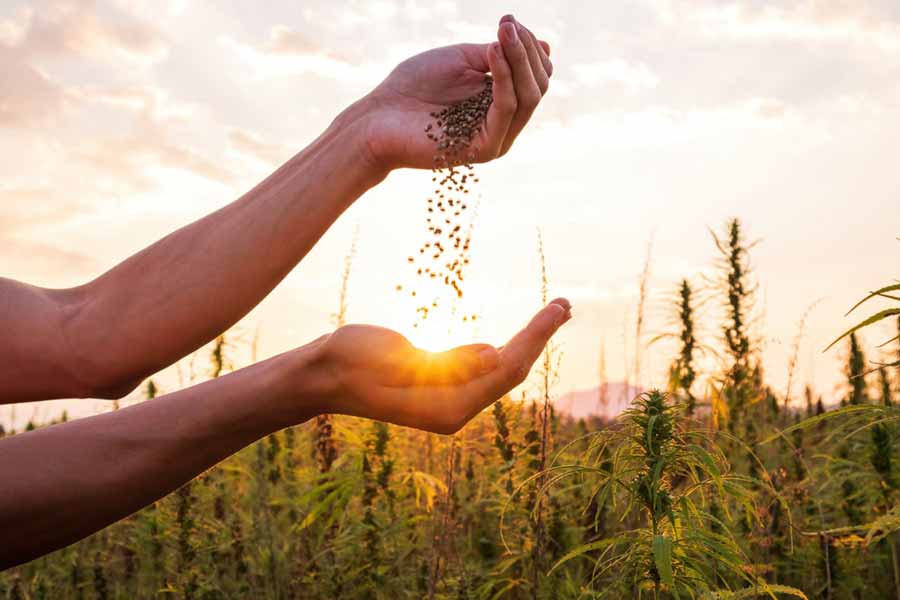
How CBD and THC support your ECS
Fortunately, you can take simple steps to help bring your ECS back into balance. Getting enough sleep, eating healthy foods, and reducing stress through exercise, mindfulness, or other stress-reducing activities may benefit your ECS.
Cannabis can also help restore balance to a struggling ECS. How does this work? The cannabis plant produces chemicals called cannabinoids that are a lot like the natural chemicals your ECS makes. The two most well-known cannabinoids are CBD and THC, though cannabis plants may contain over 100 different cannabinoids, many in trace amounts. When you use cannabis or hemp products, the CBD, THC and other cannabinoids interact with your ECS to support a return to homeostasis.
CBD and THC work by connecting directly with your ECS receptors:
- THC attaches mostly to CB1 receptors in your brain and nerves. This can help with pain, nausea, appetite issues and more.
- CBD interacts more with CB2 receptors throughout your body. This helps reduce inflammation and improves immune system functioning.

Everyone’s ECS is different
Everyone’s ECS is just a little bit different, much like everyone’s metabolism is different. That’s one of many reasons that your experience using cannabis or hemp may differ from your friend’s experience, or even your sibling’s experience.
Finding the right product and the right dose can take some trial and error, which is where our Leaf411 nurses can help. We’ve provided guidance to people who are brand new to cannabis, as well as experienced users, helping them find the best cannabis dosage and product formulations for their needs. If you’re here reading this, we’re guessing you might have some questions. Let us help! Go to our homepage at leaf411.org and click on the “Let’s Talk” button to get started scheduling your guidance call.
What is the ECS? An Intro to the Endocannabinoid System
Medically reviewed by Katherine Golden, RN, Founder and CEO of Leaf411
If you haven’t come across the term “endocannabinoid system” or ECS before, you’re not alone. Many of us didn’t learn about it in school. But it’s a vital part of our body, and it’s especially significant when considering using cannabis and hemp to support wellness or provide relief.
How the ECS was discovered
The ECS was discovered quite recently. In 1988, scientists found special receptors in rats’ brains that responded to THC, a component in cannabis. From there, we learned more:
- The ECS isn’t just in rats. It is found in all animals with spinal cords, including humans.
- The main role of the ECS? Maintaining balance in our bodies.
- The ECS is crucial for aspects like mood, sleep, metabolism, and immunity.
Learning about your CB1 and CB2 Receptors
The human body’s ECS has two main receptors, CB1 and CB2.
- CB1 receptors are primarily in our brain and spine. They’re linked with memory, behavior, appetite, movement, and pain sensation.
- CB2 receptors are spread throughout the body and play a role in managing inflammation and immune response.
Our body produces molecules called endocannabinoids that bind to these receptors. This binding signals the ECS to act, maintaining our internal balance. Sometimes, though, the ECS might need support, and that’s where cannabis and CBD hemp might come in.
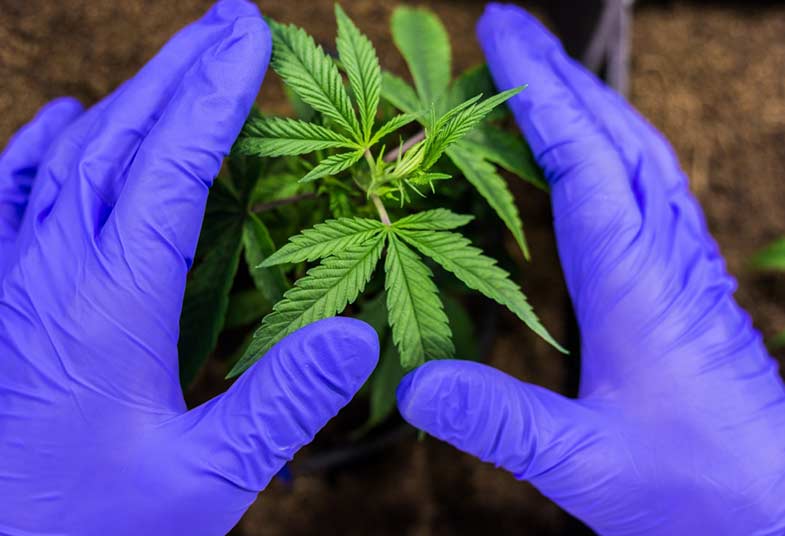
The role of cannabis in supporting the ECS
If you’re interested in a deeper dive, Dr. Dustin Sulak has created an easy-to-understand video about how cannabis interacts with the ECS.
Think of the relationship between cannabis and the ECS like this: Our body has its natural ways to manage pain. Sometimes, however, we might take additional medicine for relief. In the same way, our body creates endocannabinoids, but there are occasions where it benefits from the cannabinoids in cannabis, due to their similarity.

Leaf411 can help answer your questions about cannabis and your endocannabinoid system
If this information feels a bit complex, don’t worry. Our Leaf411 nurses have in-depth knowledge of the ECS and can help guide you on the potential benefits of CBD hemp or cannabis based on your health objectives. Please reach out to us by clicking on the “Let’s Talk” button on our leaf411.org homepage to get started.
The Ultimate Beginner's Guide to Cannabis: Understanding Flower, Concentrates, Edibles, Topicals, and More
Check out our comprehensive breakdown of popular cannabis product types before you head to the dispensary
If you’re new to the world of cannabis, the wide range of options on dispensary shelves can be exciting… and overwhelming! Even with cannabis flower (bud) which is typically smoked in bongs or pipes or rolled into joints, you’ll find all kinds of strains and options available in legal cannabis dispensaries these days.
While exploring new cannabis products can be a lot of fun, it can also be frustrating when you end up with a product that’s way too strong or not a good match for your needs. That’s one reason the Leaf411 hotline exists — to save you money and time by helping you find the best options for your cannabis experience level and wellness goals.
As a first step, though, it can be helpful to see what types of cannabis products are available today. This is easy to do using online dispensary members. Take a look at our fully-vetted Leaf411 Cannabis Dispensary Members list and pick an option in your state, then click through to the dispensary website to find their online menu.
Whether you’re looking at online menus or preparing to visit a dispensary in-person, our guide below can help you understand the potency, pros and cons of various product types:
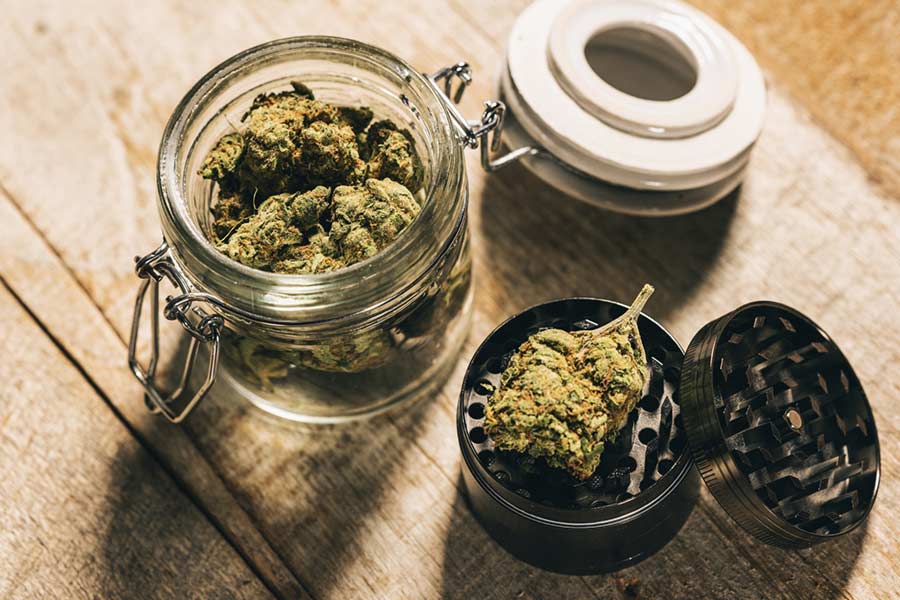
Cannabis flower
Description: Flower is the dried cannabis plant buds that are typically ground up and then smoked in a pipe, bong or rolled joints. This is the most traditional form of cannabis consumption. Cannabis flower can also be consumed using specialized dry herb vape devices which is the route most clinicians would suggest for inhalation since, with some devices, you can control the temperature for optimal results
Average THC: 10-30%
Beginner-friendly: Yes
Pros:
- Easy to use
- Wide variety of strains available
- Immediate effects
Cons:
- Requires additional accessories like a pipe, bong, rolling papers or dry herb vaporizer
- Smoking may be irritating to the lungs
- Smoking may create carcinogenic byproducts as a result of combustion
- Odor may be strong
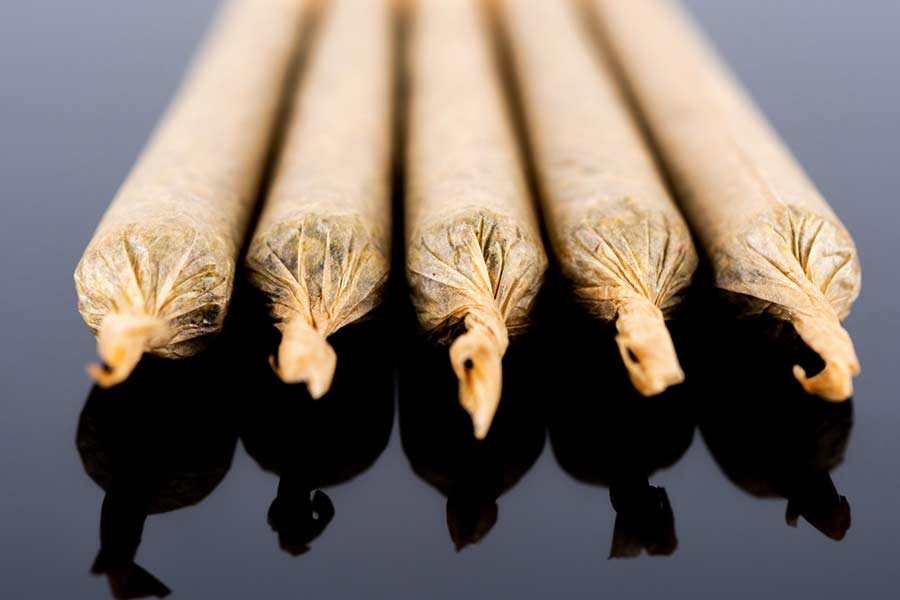
Cannabis pre-rolls
Description: Pre-rolls are pre-packaged, ready-to-smoke joints containing ground cannabis flower, usually rolled in a paper cone. Recently, there’s been a lot of innovation in this category, with live resin or hash added to pre-rolls, offering a higher-potency alternative with more pronounced effects.
Average THC: 10-30%
Beginner-friendly: Yes
Pros:
- Convenient and portable
- No rolling skills required
- Immediate effects
- More brands are offering 0.5 gram pre-rolls in addition to the standard 1 gram size. The 0.5 gram pre-rolls are ideally sized for single use
Cons:
- Some (but not all) pre-rolls are made from shake, which is lower quality than flower
- Limited strain selection compared to flower
- Can be irritating to the lungs
- Smoking may create carcinogenic byproducts as a result of combustion
- Infused pre-rolls may be overwhelming for beginners due to higher THC levels
- Odor may be strong
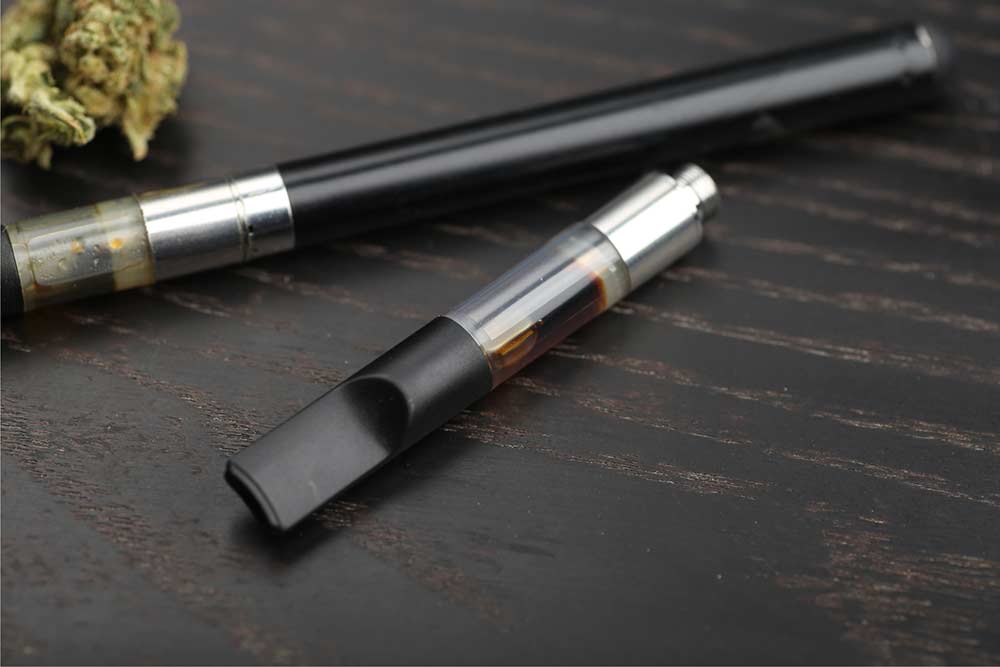
Cannabis vape cartridges and specialty pods
Description: Vape cartridges and speciality pods are pre-filled containers of cannabis oil. Most vape cartridges, or “carts,” require a separate battery heating element that the cart or pod attaches to, making up the parts of the vape pen.
Average THC: 60-90%
Beginner-friendly: Yes (start with a low dose, taking only 1-2 puffs)
Pros:
- Discreet and portable
- Can be less irritating to the lungs than smoking
- Wide variety of flavors and strains
Cons:
- High THC content may be overwhelming for beginners
- Requires a compatible battery
- Cartridges can be expensive
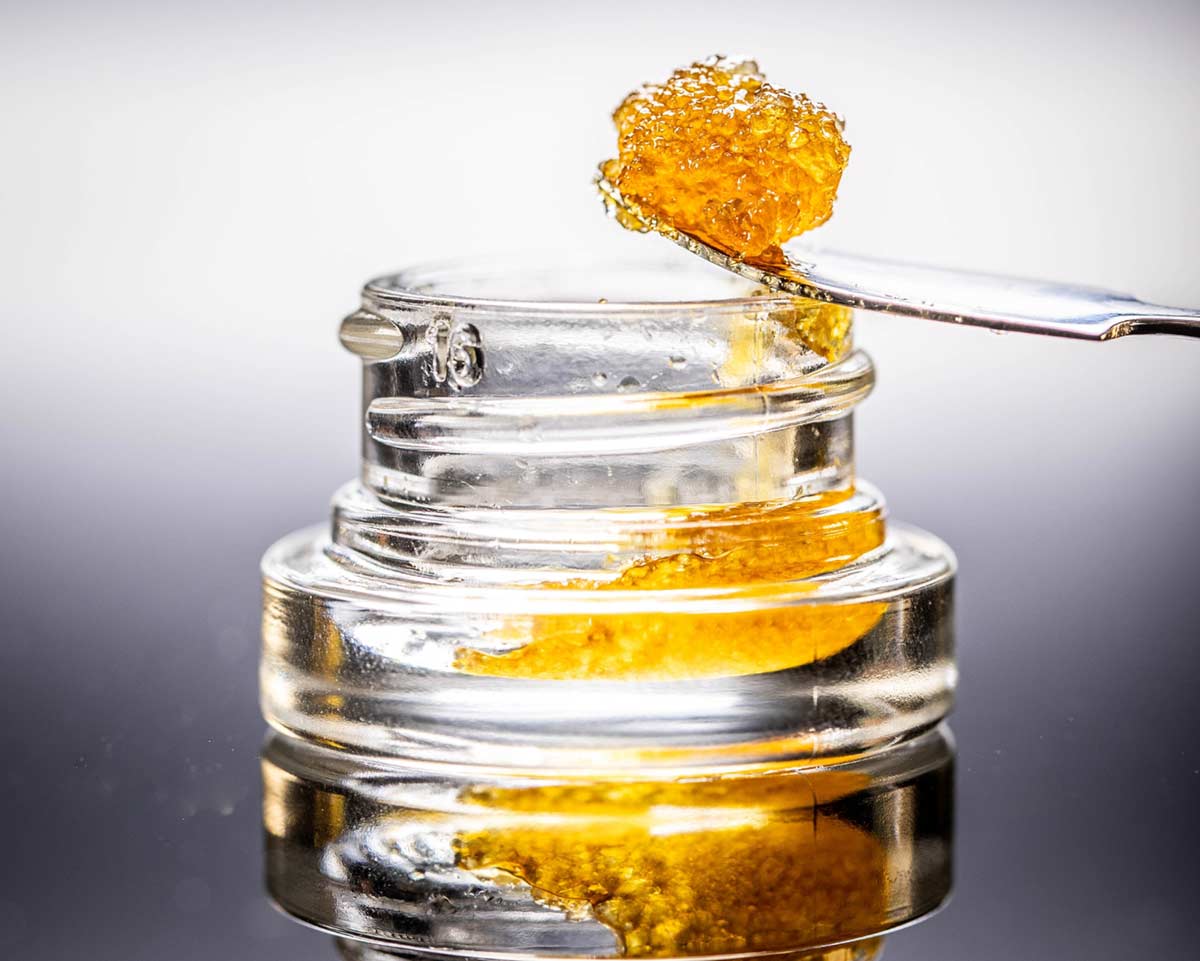
Cannabis concentrates
Description: Concentrates are highly potent extracts of cannabis, such as shatter, wax, sugar, and rosin, which can be consumed through methods like dabbing or vaporizing. Some concentrates can also be added to joints before smoking to boost potency.
Average THC: 60-90%
Beginner-friendly: No
Pros:
- Extremely potent
- Long-lasting effects
- Variety of textures and consistencies
Cons:
- Can be overwhelming for beginners
- Requires specialized equipment
- High cost per gram
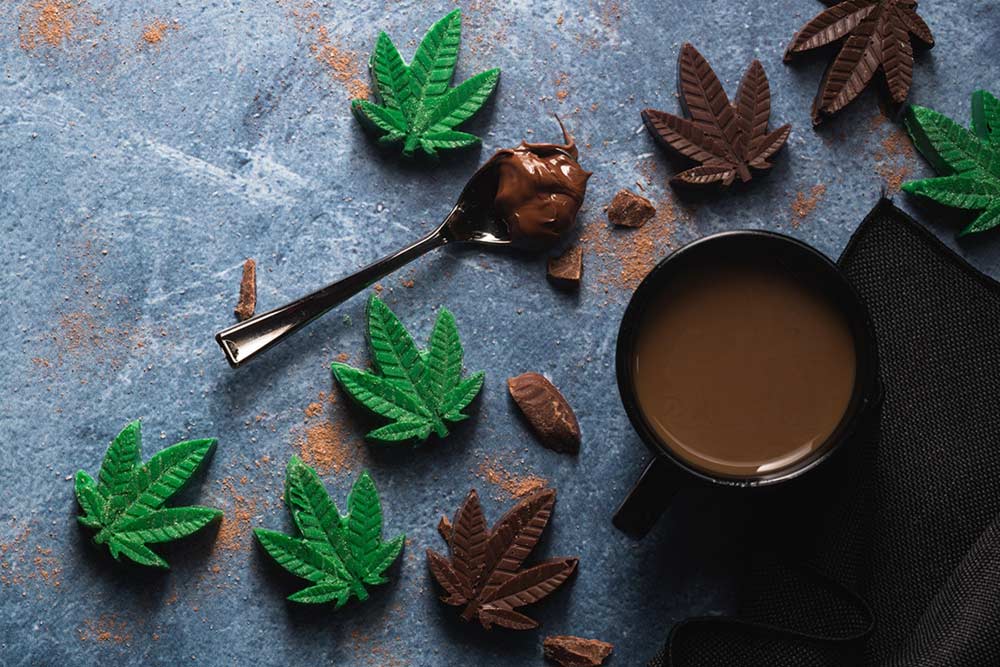
Cannabis edibles
Description: Cannabis edibles are food products infused with THC. These may include gummies, chocolates, baked goods and even popcorn.
Average THC: 5-20 mg per serving
Beginner-friendly: Yes (start with a low dose)
Pros:
- Discreet and easy to consume
- Easy to cut or section into smaller doses (start low, go slow!)
- Wide variety of flavors and products
- Most have long-lasting effects
- Some fast-acting edibles like Wana Quick gummies use nanotechnology to deliver a faster, shorter high that’s similar to smoking cannabis
Cons:
- Most have slow onset of effects (30 minutes to 2 hours)
- Easy to accidentally overconsume
- Effects may vary widely from person to person. A 5 mg gummy may be just right for one person, but too much for another.
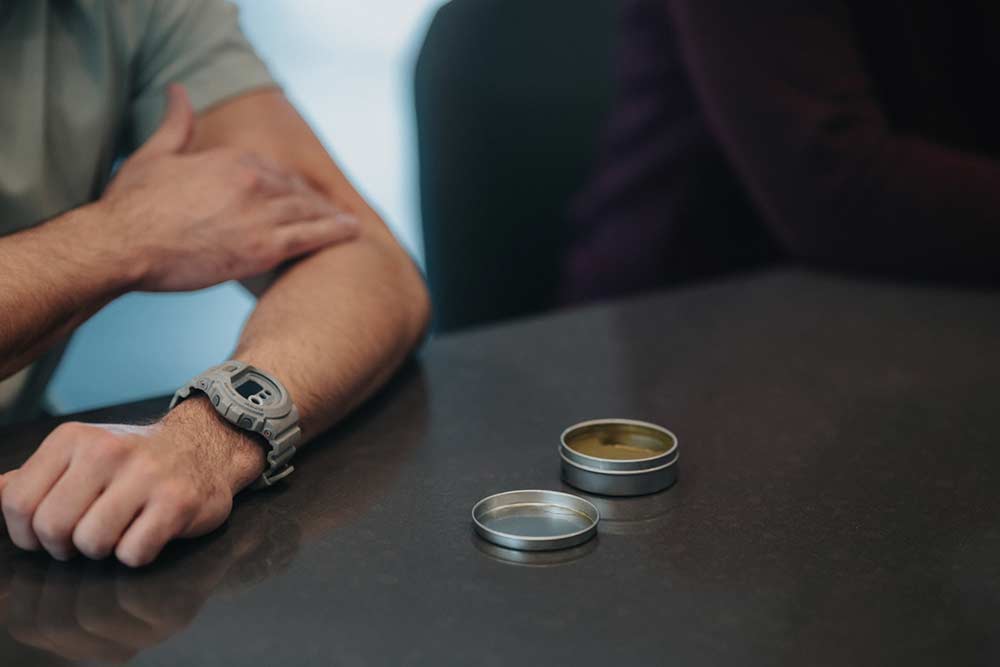
Cannabis topicals
Description: Topicals are creams, balms, and lotions infused with cannabis, designed for direct application to the skin.
Average THC: 1-10 mg per application
Beginner-friendly: Yes
Pros:
- Targeted relief for localized pain and inflammation
- Non-psychoactive
- Discreet and easy to use
Cons:
- Limited to external use
- Can be expensive

How to choose the best cannabis product for your needs
Understanding the different kinds of cannabis products is just the beginning when it comes to finding the best option for you. You should also think about things like your tolerance level, what kind of effects you want, and what you personally like. If you’re new to cannabis, always start low, using a small amount, and slowly add more until you get the feeling you want.
Not sure where to begin? Don’t worry! Our friendly, fully licensed, cannabis-trained RNs are here to help you. They can provide guidance on picking the right products, doses, and ways to use cannabis, all based on what you need and like. Also, if you have concerns about how using cannabis might affect your health or if you just want to find relief without lots of trial and error, they can answer your questions and guide you in the right direction.
To get started setting up your consultation with one of our cannabis-trained RNs, visit this link.
The Leaf411 cannabis nurse hotline provides education and directional support to the general public about the safe use of legal cannabis. We partner with select business members who meet our rigorous standards to extend our education and outreach efforts.
How to Find the Best 420 Cannabis Deals: A Checklist
Check out our tips on finding the best promotions and products for your budget. Plus, learn about the deals on hemp CBD products during 420.
Looking for the best deals on cannabis products during 420? Happening each year on April 20, the 420 cannabis-themed holiday offers amazing discounts on all sorts of legal cannabis products.
However, with so many brands and dispensaries offering special sales on cannabis edibles, concentrates, flower, and more, it’s easy to go overboard. Just because something is a good price doesn’t mean it’s a good deal. If you’ve ever impulse-bought a deeply-discounted kitchen appliance only to have it collecting dust under the countertop, you know what we mean!

Making your 420 cannabis shopping game plan:
- Be realistic about how much cannabis you typically consume so that you don’t buy more than you’ll use before flower or other products lose their potency.
- Identify the types of cannabis products you’re interested in–for example, cannabis flower, vapes, edibles, tinctures or topicals.
- Curious about certain cannabis brands or product types, for example, Wana Optimals gummies designed for sleep or Seed & Smith’s newest flower strains? The 420 holiday provides a great opportunity to try new products at a discount.
Feeling overwhelmed on where to start? Our Leaf411 cannabis-trained nurses can help guide you, whether you’re just starting to explore options or looking to change your current product use. Sign up for a 30 minute cannabis nurse consultation here.

How do you find the best 420 cannabis deals to fit your budget? Our checklist has you covered:
- Prior to 420, sign up for dispensary loyalty programs or newsletters that regularly announce promotions and sales. You can also regularly check dispensary websites or ask the budtenders about upcoming promotions. Our fully-vetted Leaf411 member directory is a great place to start!
- Check your favorite brands’ websites for newsletter sign-ups and sales announcements. Our most-trusted cannabis brands at Leaf411 include Wana, Mary’s Medicinals, 1906, Escape Artists, and Jenny’s Rose.
- Many 420 deals will last for the entire month of April. Unless a product is a limited run, you can likely go back and buy more on sale if it’s something you like.
- Keep in mind that by law, dispensaries do not allow product returns. If you blow your 420 budget on multiple boxes of THC-infused popcorn and then decide you don’t like it, you’re out of luck. All sales are final.
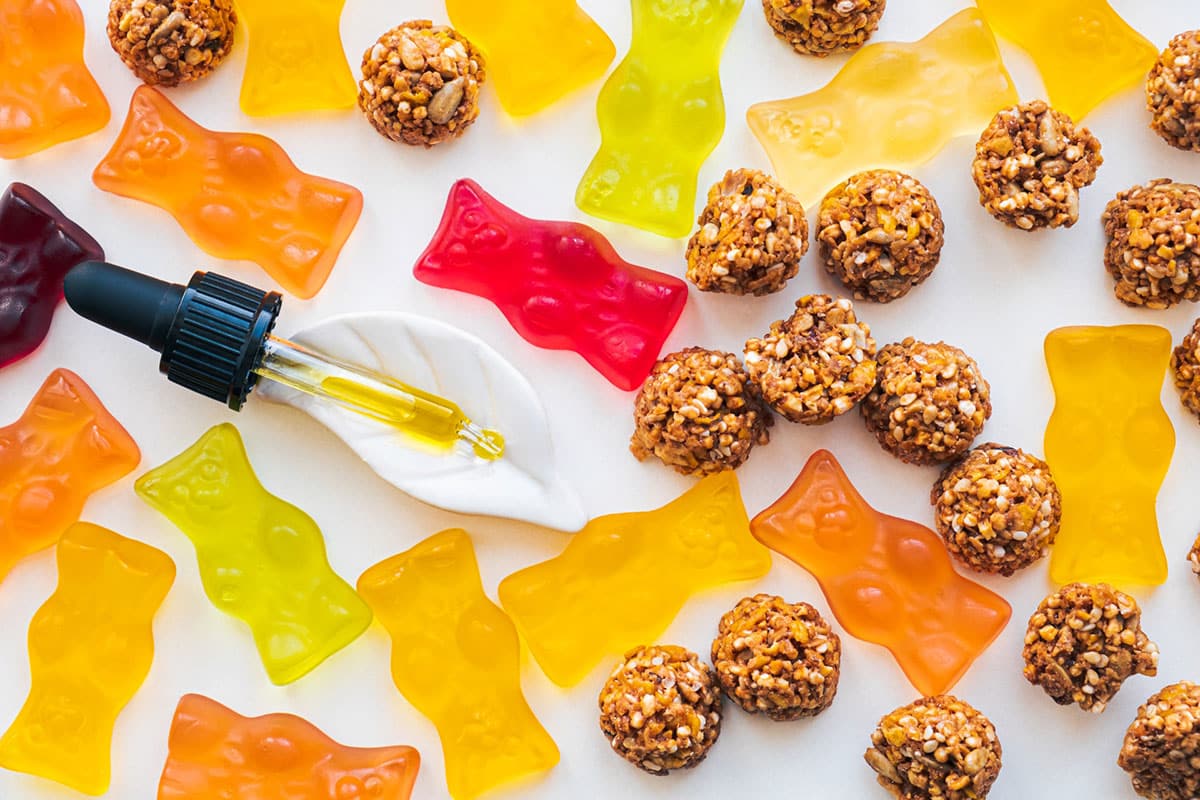
What about hemp CBD products? Will they be on sale during 420?
Hemp CBD manufacturers also get in on the action during 420, offering special sales and promotions. After all, both CBD and THC come from the same plant species. We love how Michigan State University explains the difference between hemp and marijuana in their newsletter:
“Both hemp and marijuana belong to the same species, Cannabis sativa, and the two plants look somewhat similar. However, substantial variation can exist within a species. After all, great Danes and chihuahuas are both dogs, but they have obvious differences.
The defining difference between hemp and marijuana is their psychoactive component: tetrahydrocannabinol, or THC. Hemp has 0.3% or less THC, meaning hemp-derived products don’t contain enough THC to create the “high” traditionally associated with marijuana.”
Hemp CBD doesn’t fall under the same restrictions as cannabis products containing over 0.3% THC. Hemp CBD products can be sold online and shipped across state lines. This opens up thousands of options when it comes to buying CBD on sale during the 420 holiday.
While it’s great to have so many options, the hemp CBD marketplace also lacks many of the regulations that govern the legal cannabis marketplace. Trustworthy, high-quality hemp manufacturers will voluntarily provide third-party Certificates of Analysis (COAs) for product lots that show results for cannabinoid levels and presence of contaminants such as pesticides, heavy metals, and residual solvents. These COAs are typically provided on the manufacturer website.
Of course, you can also check our Hemp CBD Manufacturer and Retailer Directory for hemp CBD companies that our Leaf411 nurses know and trust.
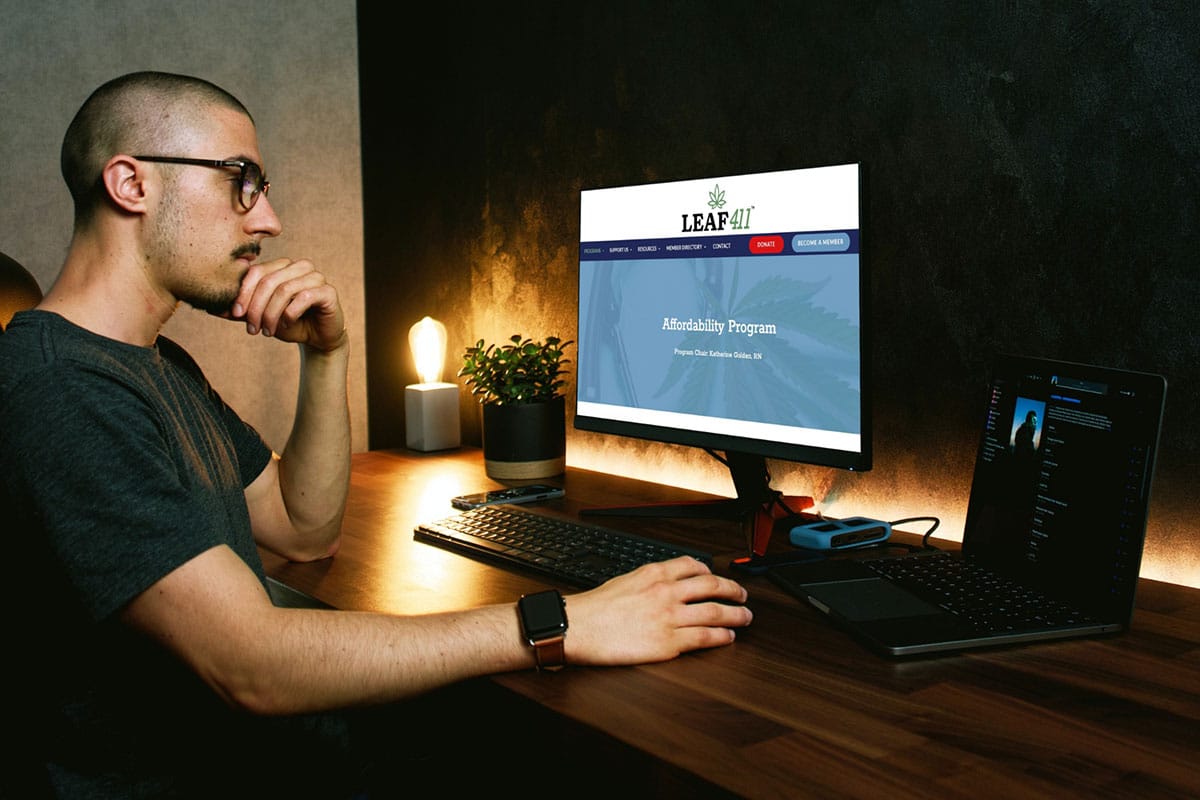
Other ways to save money on cannabis
While 420 is known for epic deals on cannabis, it’s not the only time of year that you can take advantage of special promotions and sales. Many dispensaries run specials during other major holidays, and manufacturers often deeply discount products when first launching them, as well as when products are getting close to their expiration date.
Not everyone has the expertise or time to track all the specials, though, especially patients who are dealing with serious health concerns. We understand. That’s why we created the Leaf411 Affordability Program to help MMJ patients who are experiencing financial hardship, offering low-cost or free hemp CBD and THC dispensary products to program participants. We encourage you to check out our Leaf411 Affordability Program information page and reach out if you have questions about whether you qualify.
For patients and consumers: Learn more about Leaf411’s Affordability Program here.
For cannabis manufacturers who want to help us meet the needs of MMJ patients, visit our Leaf411 Membership page or contact us directly to learn how you can contribute products to our Affordability Program.
Do You Need a Medical Marijuana Card?
By Katherine Golden, RN – Founder and CEO of Leaf411
“Should I get a medical marijuana card?” We hear that question a lot on the Leaf411 cannabis nurse hotline, as callers seek out the best way to access legal cannabis.
We can help you sort out your options based on your needs as well as what options exist where you live. Check out our Leaf library for your state’s current cannabis laws.
Is Legal Recreational Marijuana an Option for You? Then You Might Not Need a Med Card
Many of our callers are just starting out using cannabis and only require small doses of THC. Lower dose products are more easily found in recreational dispensaries. You don’t need a medical marijuana card (often called an “MMJ card” or “med card”) to visit adult use or recreational (rec) dispensaries. However, you’ll need a state-issued ID as proof that you are 21 or older.
Also, it’s worth noting that cannabidiol (CBD hemp) containing less than 0.3% THC is federally legal. CBD hemp (may also CBDa, CBN, and CBG) products are available over-the-counter and online in nearly every state, no med card required! Check out a list of Leaf411 nurse vetted Hemp members here.
If you’re just starting out with cannabis and live in a fully legal state that has both rec and medical marijuana, we suggest reaching out to a cannabis-trained clinician first for advice on the best routes, ratios and products. Our Leaf411 hotline is the perfect first-step resource!
In many cases, these products will be available to you without a med card, saving you both the time and cost of applying for a card.
David Gordon, MD, a Leaf411 advisory board member and integrative medicine practitioner notes that, “In Colorado, a lot of the products that we might use for medicinal purposes are only available on the rec side. Companies aren’t making as many products for the medical side because it’s not as profitable.”
While it can be challenging to find products made specifically for the medical market, there are brands that do a great job creating products specifically for medical use. One of our supporting members, Wana Brands, is a great example.

Understanding Med Card Qualifications
Before we get into cases when a med card makes sense, it’s important to talk about the qualifications for getting a medical marijuana card. Covered conditions vary from state to state. For example, in Colorado, the state list includes specific disabling or debilitating conditions. Oklahoma, on the other hand, is one of the least restrictive states. Their law leaves it up to the doctor to determine if cannabis is a good treatment option.
Check this link for an updated list of different states’ qualifying medical conditions.
When a Med Card Makes Sense
Some states only legalized medical marijuana, not recreational use. If you live in one of these states, then your only option for accessing legal cannabis is by qualifying for a med card.
Med cards are also the only option for people under the age of 21 to access legal cannabis.
It’s important to know what a med card gets you, as well as what protections it does not provide (you might be surprised!).
What a Med Card Provides in Some States
- Access to products at lower cost than recreational dispensaries
- Lower sales taxes when buying at a medical dispensary
- Higher doses and higher limits on how much you can buy in a day
- The ability to legally grow your own cannabis for personal use in some (but not all) states
What the Med Card Doesn’t Do
It’s important to remember that all marijuana—medical and recreational—remains federally illegal, even when legalized at the state level.
- A med card doesn’t give you the right to smoke in your rental if prohibited by lease
- A med card doesn’t prevent your employer from firing you for positive drug test results.
- Holding a med card may disqualify you from certain jobs or impact your career or educational options, though many states are also enacting legislation on this front.
Other Considerations Before Getting a Med Card
Will a med card restrict your right to own firearms? The answer is tricky.
Cannabis is federally illegal, and the feds oversee gun licensing and ownership. By the letter of the law, anyone using a federally illegal drug, or addicted to an illegal drug, is prohibited from owning or buying firearms.
If you’re buying a gun, you typically must complete a background check—specifically, the Firearms Transaction Record, or Form 4473. This form includes a question specific to marijuana use, and reinforces the federal prohibition, asking:
Are you an unlawful user of, or addicted to, marijuana or any depressant, stimulant, narcotic drug, or any other controlled substance?
Warning: The use or possession of marijuana remains unlawful under Federal law regardless of whether it has been legalized or decriminalized for medicinal or recreational purposes in the state where you reside.
In other words, if you answer truthfully (and you should—lying on Form 4473 is considered a felony offense!), then your background check may fail.
At Leaf411, we’re nurses, not lawyers. We recommend that you consult with an attorney if you have concerns about whether your cannabis use will impact your right to own or buy firearms.
A number of law firms now specialize in marijuana law. In fact, our board member David Wunderlich, Esq., Senior Attorney at McAllister Garfield, P.C., played a key role in improving Colorado’s laws around medical marijuana, and regularly speaks on cannabis and hemp issues.
Medical marijuana use may also impact state-administered public assistance benefits such as Temporary Assistance to Needy Families (TANF) in states that drug test welfare recipients. Interestingly, in Missouri, having a med card can actually protect your benefits. However, the rules vary from state to state and are frequently being updated. We strongly suggest you ask your social service agency whether holding a med card would impact your public assistance benefits.
How to Apply for a Med Card
You’ve weighed the pros and cons, as well as options available in your area, and have decided to get a med card. Where do you start? Search online using “med card” and your state to find state-specific information for obtaining a medical card in your area.
- Check your eligibility, making sure you have a qualifying medical condition.
- Confirm any special requirements, such as if you’re applying as the legal representative of another adult or someone under 18.
- Note the process for obtaining a card, including required fees. In some cases, discounts may be available for specific patient groups. For example, Oklahoma provides a discount to 100% disabled veterans.
- Find a doctor who provides medical marijuana evaluations. Your regular primary care provider may provide this service, though many primary care doctors may be unfamiliar with the med card evaluation process.
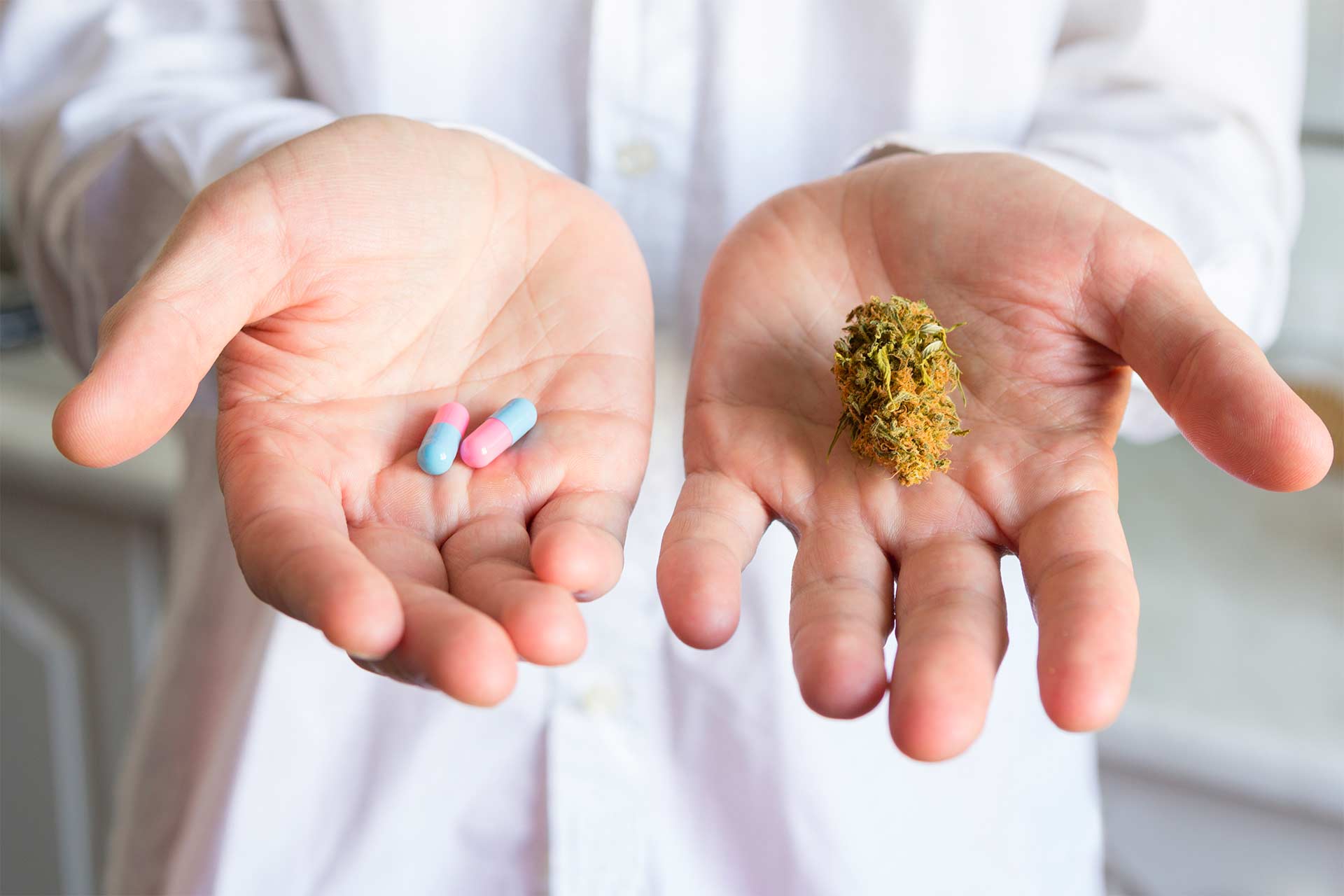
How a Med Card and a Prescription Are Different
You may think that the med card evaluation process will be a lot like getting a prescription from your primary care doctor. In fact, that’s rarely the case! The doctor’s certification simply tells the state that you qualify for a med card based on their assessment of your health history and conditions. It doesn’t tell you which products to start with or how much to take.
When you schedule a med card consultation, it’s worth asking whether the provider provides guidance on using cannabis to treat your health condition. If they do not, you may want to seek out a cannabis doctor who provides this service, such as Dr. David Gordon, who we recently interviewed or check out the Leaf411 vetted cannabis clinician on this page.
You can also reach out to a resource like the cannabis-trained nurses at Leaf411 for suggestions on where to start.
A Note for Patients Living in States Without Legal Cannabis
Cannabis containing over 0.3% THC remains completely illegal in 17 states. However, federally-legal CBD hemp products containing less than 0.3% THC are legal in almost all states. Full spectrum CBD hemp products contain many beneficial plant compounds shown to impact a variety of health conditions. In fact, even in states with legal cannabis, we sometimes suggest starting with CBD hemp products for certain health concerns.
At Leaf411, our cannabis nurses emphasize the safe legal use of cannabis. When you call, we listen to your specific needs and concerns. We will help find options and guide you to resources that best fit your lifestyle and health goals.
The Leaf411 cannabis nurse hotline, chat and scheduled nurse guidance call services provide education and directional support to the general public about the safe use of legal cannabis. We partner with select business members who meet our rigorous standards to extend our education and outreach efforts.
How Cannabis May Help with Different Types of Pain
From acute to chronic pain, cannabis can be a path towards restored function
By Katherine Golden, RN – Founder and CEO of Leaf411
Much like any other medicine, cannabis is not a magic pill, it is a tool. From the available research and our own experiences working with patients, we have found that the cannabis plant may be an effective alternative or adjunct therapy to potentially lower the doses of opiates or nonsteroidal anti-inflammatory drugs (NSAIDs) like ibuprofen and acetaminophen that can cause unwanted side effects.
Cannabis Can Be a Powerful Tool For Pain
When it comes to pain, everyone is different. How you experience pain, as well as your pain tolerance level, is shaped by a lot of different factors. In the same way, people respond to medicines differently.
Cannabis is emerging as a different option, proving to be a powerful new tool for managing pain. The cannabinoids in the cannabis plant, especially cannabidiol (CBD) and tetrahydrocannabinol (THC), have been shown to reduce inflammation and pain. Other cannabinoids (CBDa, THCa and CBG) plus plant compounds like terpenes may also play a role in reducing pain.
Federal restrictions in the United States continue to limit research on how cannabis impacts pain. However, other countries such as Israel have completed considerable research on cannabis’s therapeutic benefits.
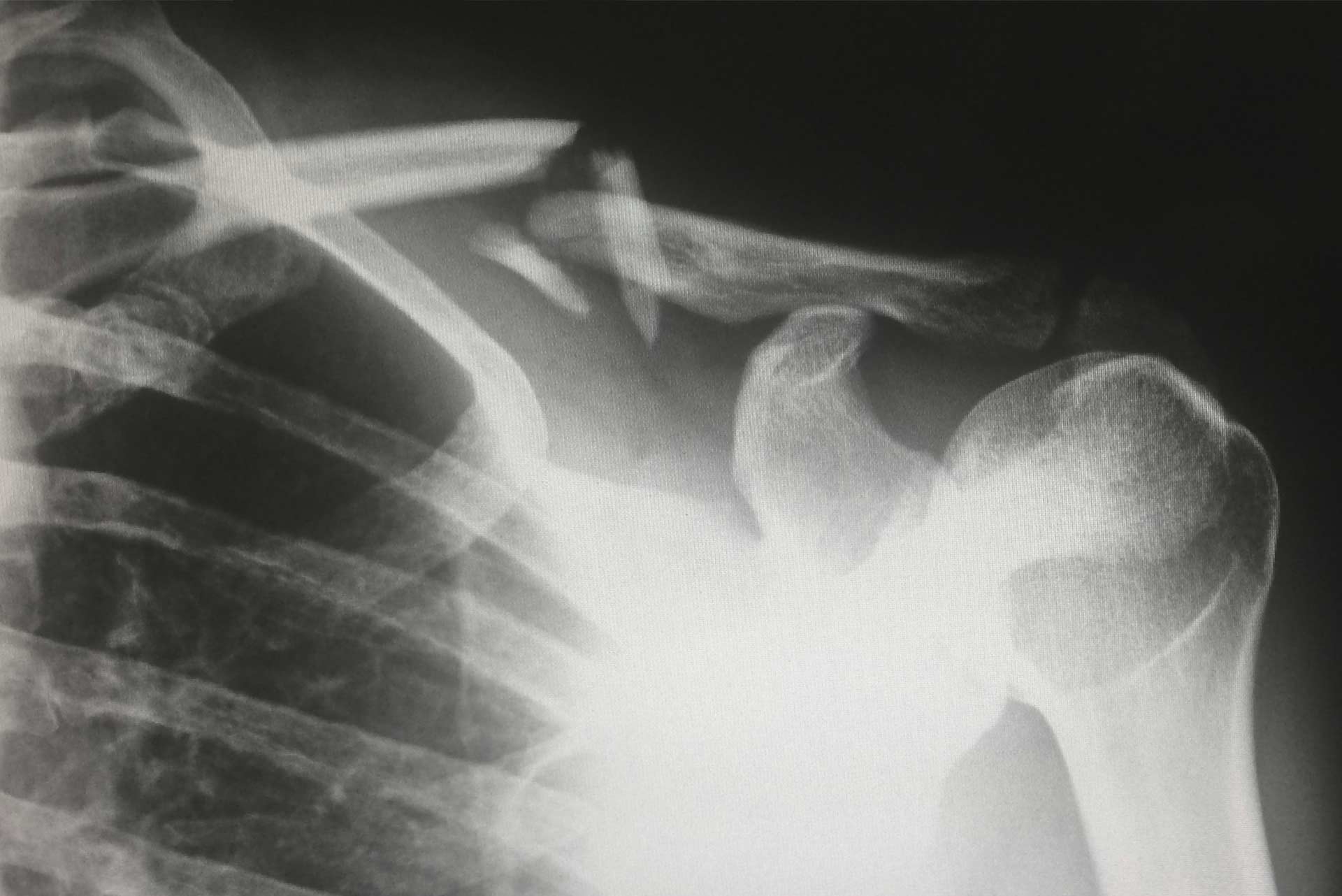
What Are the Different Types of Pain?
Understanding the different types of pain and their sources can help you find the best cannabis options.
- Acute pain usually comes about as the result of an injury, overuse, or medical procedure. While the initial pain can be mild or severe, it gets better over time as your body heals. Slamming your finger in a door results in acute pain. Post-workout soreness, broken bones and surgery recovery also fit into this category.
- With chronic pain, “the pain itself becomes the disease,” explains Eduardo Fraifeld, MD. Doctors typically categorize pain lasting over 3-6 months as chronic pain. Chronic pain can be associated with arthritis, migraines, diabetes or multiple sclerosis (MS), among other conditions. It can also be a side effect of chemotherapy or other long-term medical treatments. In addition, when an injury heals yet the pain remains, that fits the description for chronic pain.
Pain can also be broken down into the following categories:
- Nociceptive pain: Pain in soft tissues, tendons or joints caused by injury, overuse, stress or illness. Arthritis and other types of inflammatory pain also fit in this category. Nociceptive pain tends to get better over time, except for arthritis. With this type of pain, inflammation triggers nearby nerves, resulting in aching or throbbing pain.
- Neuropathic pain: Neuropathic pain, or nerve pain, originates in the nervous system. This type of pain is chronic in nature. It often feels like pins and needles, an electric shock, or a burning sensation. Some common causes of neuropathic pain are carpal tunnel syndrome, sciatica, diabetes, and chemotherapy.
- Nociplastic pain: Is a relatively new category for pain that doesn’t fit well into the other two categories. Fibromyalgia, non-specific low back pain and irritable bowel syndrome are a few examples. Also, pain associated with and exacerbated by centralized and peripheral sensitization is an example of nociplastic pain.
THC or CBD? It Depends on the Person and the Type of Pain
Cannabis plant compounds (cannabinoids) work on the CB1 and CB2 receptors in your body’s endocannabinoid system.
Everyone’s endocannabinoid system is different, just like everyone has their own pain tolerance levels. Keep this in mind if a product ends up not working for you, there may be a better product or dose for you. You can always call our registered nurses at Leaf411 for guidance.
CBD: Many people successfully use CBD products to reduce inflammation-based pain. Full spectrum products containing all the plant compounds, including some amount of THC (including CBD hemp that has THC, tend to be the most effective. Primarily because minor cannabinoids, terpenes, flavonoids and essential fatty acids work together to create the “entourage effect.”
By helping to reduce inflammation, CBD may indirectly help reduce pain. However, it doesn’t bind directly to the receptors that control pain like an opioid does. For that, you need a different cannabinoid, THC.
THC: A lot of people immediately rule out products with THC because they’re concerned they will become impaired or “high.”
It’s important to know that small amounts of THC may have little to no impairing effects. At the same time, THC—even small amounts—can be a gamechanger when it comes to pain.
THC can act on the same receptors in your body that opioids do. However, you don’t get some of the problematic side effects that opioids can bring—nausea, constipation, and risk of physical addiction.
Cannabis plant compounds (cannabinoids) work on the CB1 and CB2 receptors in your body’s endocannabinoid system.
Everyone’s endocannabinoid system is different, just like everyone has their own pain tolerance levels. Keep this in mind if a product ends up not working for you, there may be a better product or dose for you. You can always call our registered nurses at Leaf411 for guidance.
CBD: Many people successfully use CBD products to reduce inflammation-based pain. Full spectrum products containing all the plant compounds, including some amount of THC (including CBD hemp that has THC, tend to be the most effective. Primarily because minor cannabinoids, terpenes, flavonoids and essential fatty acids work together to create the “entourage effect.”
By helping to reduce inflammation, CBD may indirectly help reduce pain. However, it doesn’t bind directly to the receptors that control pain like an opioid does. For that, you need a different cannabinoid, THC.
THC: A lot of people immediately rule out products with THC because they’re concerned they will become impaired or “high.”
It’s important to know that small amounts of THC may have little to no impairing effects. At the same time, THC—even small amounts—can be a gamechanger when it comes to pain.
THC can act on the same receptors in your body that opioids do. However, you don’t get some of the problematic side effects that opioids can bring—nausea, constipation, and risk of physical addiction.
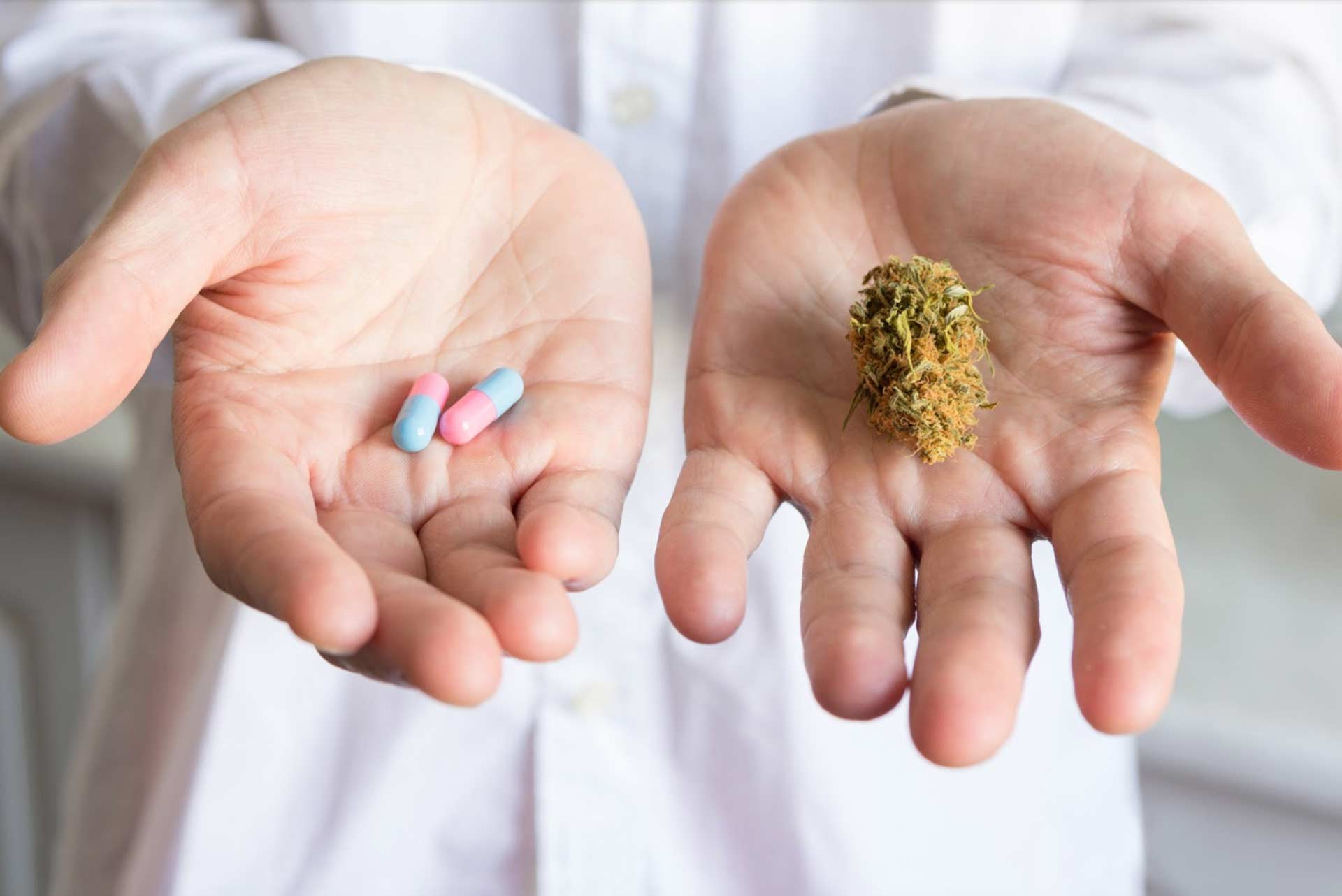
Cannabis Compared to Opiates
Ironically, long-term use of opioids for chronic pain can make you more sensitive to pain—an effect called opioid-induced hyperalgesia. What’s the recommended protocol in response to opioid-induced hyperalgesia? To wean off of opioids(with help from your prescribing physician) and find a safer alternative for managing pain. Interestingly, cannabis has shown promise on this front, based on emerging research.
Cannabis does not cause pain sensitization but in fact can help treat it. THC and other cannabinoids work through the same receptors that opioids do. However, the way that they reduce pain (their chemical process) is different.
Neuropathic pain is difficult to treat even with conventional pharmaceuticals. Generally, opioid use for chronic neuropathic pain is ineffective. One study considered the risk and benefits of opioids for the treatment of neuropathies. It stated that “long-term opioid therapy didn’t improve the functional status but rather was associated with a higher risk of subsequent opioid dependency and overdose.”

The Goal: To Restore Function
We wish that we could tell you that CBD or THC products will completely eliminate all pain. However, that is not the case. If there were a magic one-size-fits-all cure for pain, the pharmaceutical companies would have discovered and patented it!
Instead, we always set the goal to reduce pain to a manageable level and restore function. When you restore function, you open the possibility of adding on additional supportive activities such as exercise and relaxation that further promote healing.
Can’t wait to get started? Our Leaf411 quick question hotline and one-on-one scheduled nurse guidance calls are available now to answer your questions about using cannabis to manage pain. Call us at 844-LEAF411 (844-532-3411).
The Leaf411 cannabis nurse hotline provides education and directional support to the general public about the safe use of legal cannabis. We partner with select business members who meet our rigorous standards to extend our education and outreach efforts.
Timing Your Dose: How Different Cannabis Products Reduce Pain
by Katherine Golden, RN – Founder and CEO of Leaf411
You have options when it comes to cannabis dosing
Whether you’re looking at CBD hemp or cannabis containing higher levels of THC, you have several different routes of administration to choose between:
- Inhalation (smoking, vaping): Takes effect immediately and lasts 2-4 hours. This is a great choice for instant relief and for treating breakthrough pain (a flare-up in pain). You can also layer inhaled cannabis with a longer-acting method to help get you through the night.
- Transdermal (patches, gels): Extended release option that takes effect quickly, since the cannabinoids are absorbed directly into your bloodstream. The time of onset is rapid, sometimes within 20 minutes. Transdermal products provide a consistent dose of medicine for up to 12 hours. The transdermal patch or gel is used on an area where the veins are near the skin’s surface—like the inside of your wrist or on your ankle.
- Sublingual (placed under the tongue): Sublingual administration can provide rapid relief, however, there are few true oromucosal (sublingual) products on the market. Cannabinoids are fat-soluble and, in their natural state, do not absorb well into the oral mucosa. Moreover, cannabis products are often extracted into oils, and these products are not water-soluble. Patients often expect rapid onset when using tinctures, only to wait 1-3 hours for the dose to take effect. Many products marketed as tinctures will end up being swallowed and absorbed via the digestive system, regardless of how long they are held under the tongue. A true sublingual (a product in which the cannabinoids are formulated to be more water-soluble) absorbs rapidly into the mouth. The effects can be perceived in 15-20 minutes and can last 4-6 hours.
- Edibles (gummies, capsules): Edibles take effect in between 30 minutes and 2 hours. You’ll feel their effects between 5-8 hours. They provide a discreet, portable long-acting option.
- Topicals (creams, salves): Topicals provide short-term localized relief. They can take effect within minutes, and may last for up to an hour.
It may take some trial-and-error to determine just which type of product works for you. In fact, you may discover that there are different routes of administration for different symptoms you are experiencing. For assistance identifying what works for you, contact a cannabis-trained nurse at Leaf411.
The Leaf411 cannabis nurse hotline, chat and scheduled nurse guidance call services provide education and directional support to the general public about the safe use of cannabis. We partner with select business members who meet our rigorous standards to extend our education and outreach efforts.
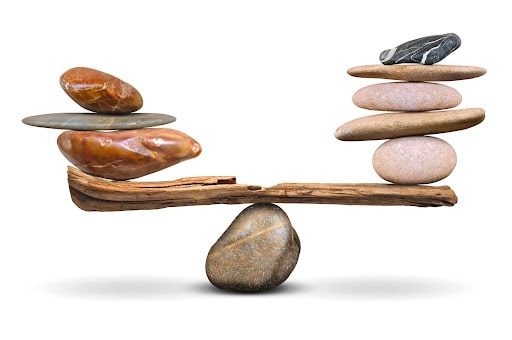
How to Dose Cannabis: Start Low and Go Slow
Dose sizing can be complicated
by Katherine Golden, RN – Founder and CEO of Leaf411
You may remember when the U.S. government sought to simplify food labeling. This was done to make the connection between serving sizes and calories more clear. Confusion around serving size was causing many people to eat or drink a lot more calories than they realized.
Today, we are at a similar spot when it comes to cannabis products, especially edibles. Some manufacturers put the per-dose strength on the product label and some do not. For example, the package might say “10mg CBD/5mg THC.” However, other manufacturers may put the total amount of THC and/or CBD for the entire package instead.
Also, laws restricting the amount of THC per edible vary between states that have legalized cannabis. Limits may also be different depending on whether the product is designed for recreational or medical consumer sales. For example, Colorado’s suggested serving size for an edible is 10mg which would be far too much THC to consume for a first time user.
How do you get the dose you want?
- If you are unsure about the product strength, ask your budtender for help understanding the amount that is in the product before purchasing. Does the package labeling show the amount of THC and CBD per dose, or does it show the amount in the entire package?
- Check in with our Leaf411 nurses. We’ll help answer your questions about product labels and doses. We can also suggest a good starting point based on your individual needs and goals.
- Start low and go slow when trying any new product. The Leaf411 nurses always suggest starting with an amount below the suggested serving size for safe consumption. You may not feel an immediate change or symptom relief. However, starting low and moving up slowly will ensure you do not over consume for your body’s tolerance or specific needs.
- Understand that some product types act more quickly than others. For example, vaping provides more immediate short-term impact, while edibles can take a few hours to take effect. We’ll explain this in detail as we review different types of products below.
It may take some exploring for you to find your favorite method of consuming cannabis or CBD hemp.
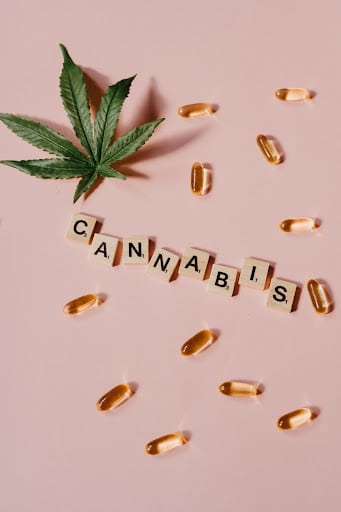
What’s the Best Way to Use Cannabis for Relief?
What method of ingestion works best for you? If you ask budtenders, friends, or people on internet forums, they will likely recommend what has worked best for them—and that may not match your needs.
Also, high-quality cannabis and CBD hemp products can be expensive. Many of us cannot afford to spend a lot of money testing different options that may or may not work.
Our Leaf411 cannabis-trained nurses have extensive knowledge on how to best use cannabis and CBD hemp for specific conditions. We provide balanced guidance and education that takes into account your individual needs, whether you have a limited budget, live someplace where you cannot access state legal cannabis, or are trying to find alternatives to conventional medications.
The Leaf411 cannabis nurse hotline provides education and directional support to the general public about the safe use of legal cannabis. We partner with select business members who meet our rigorous standards to extend our education and outreach efforts.



